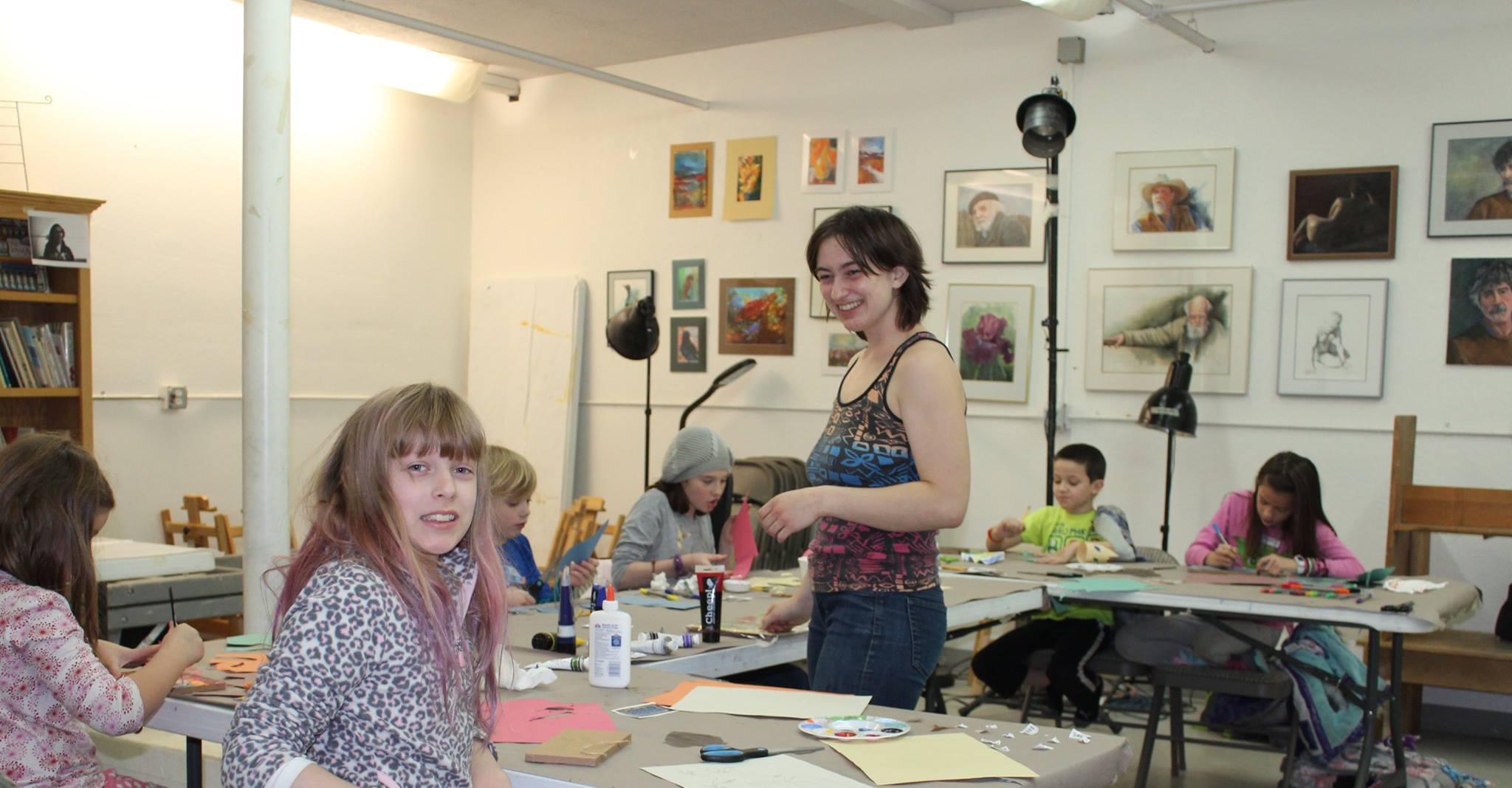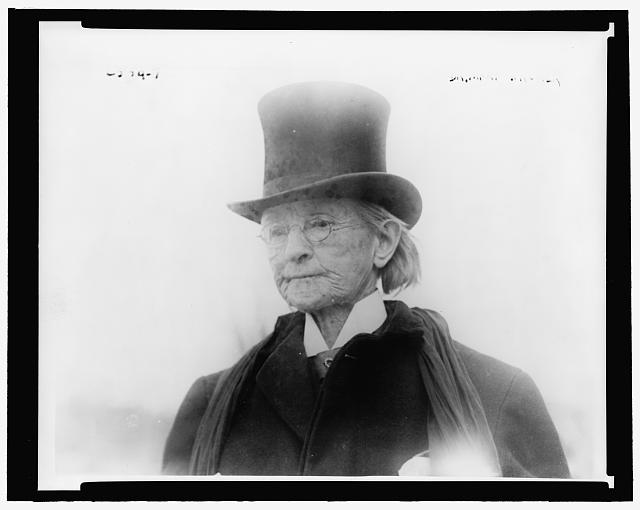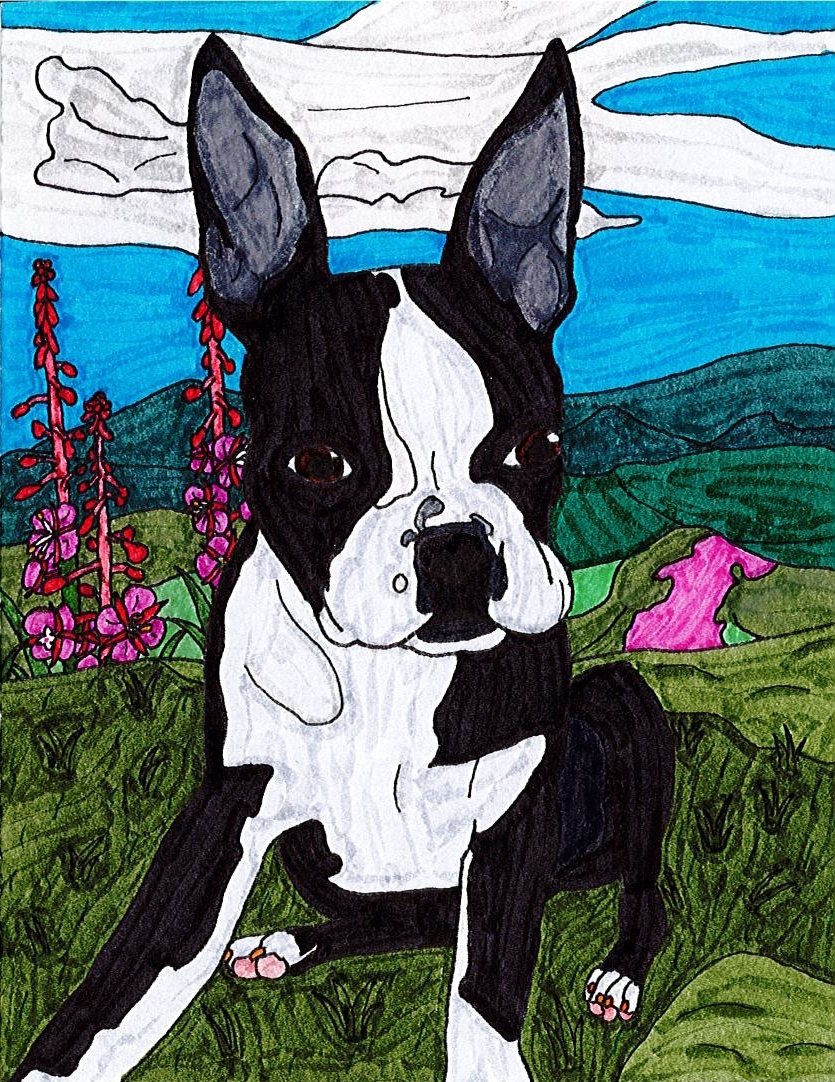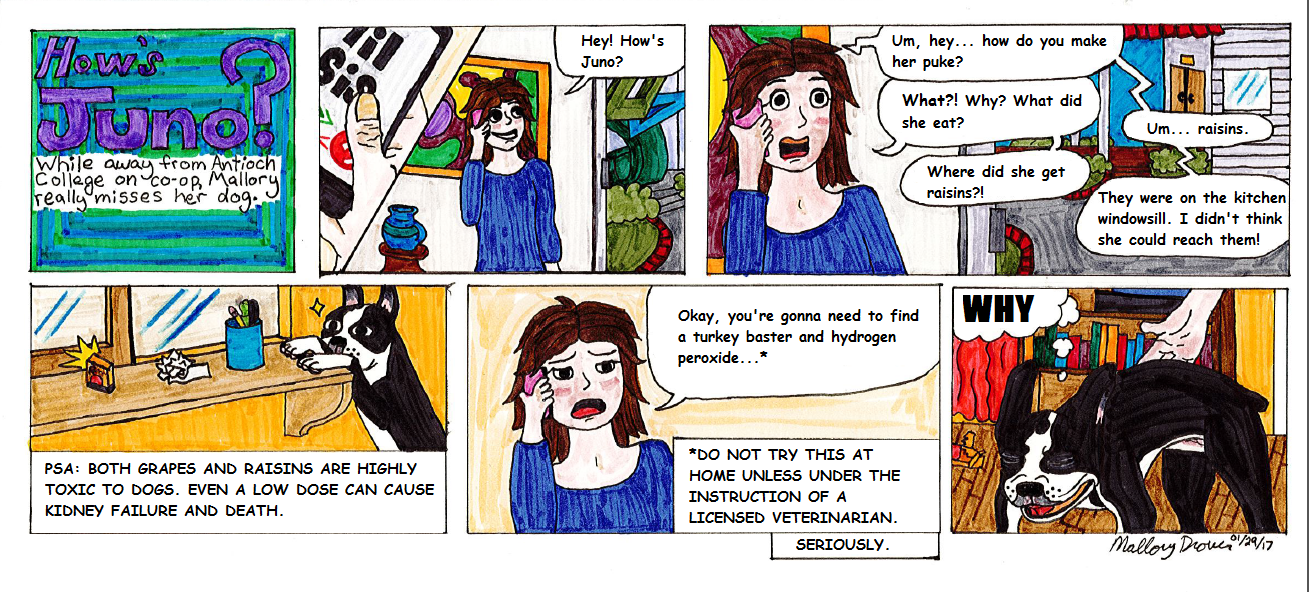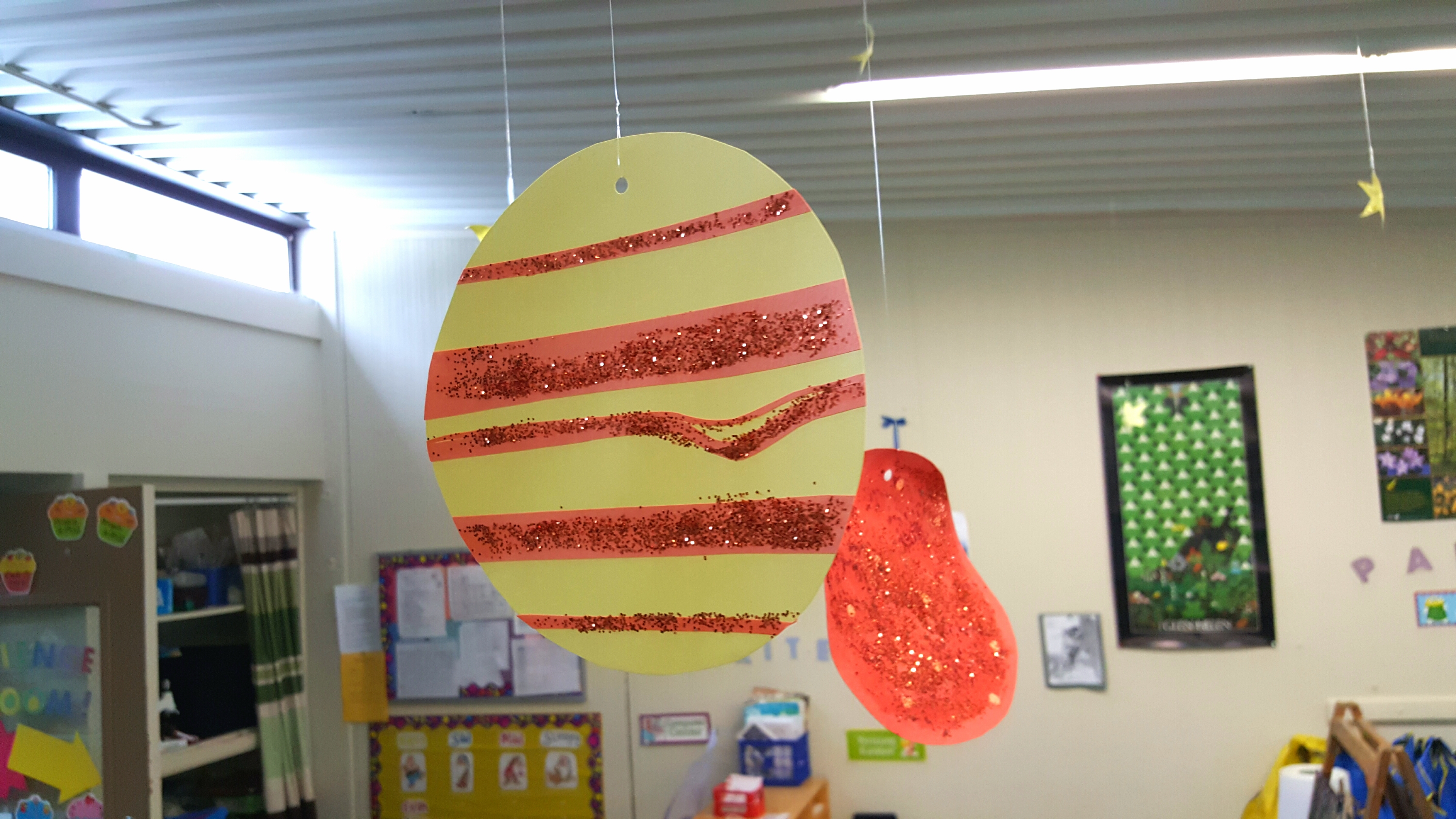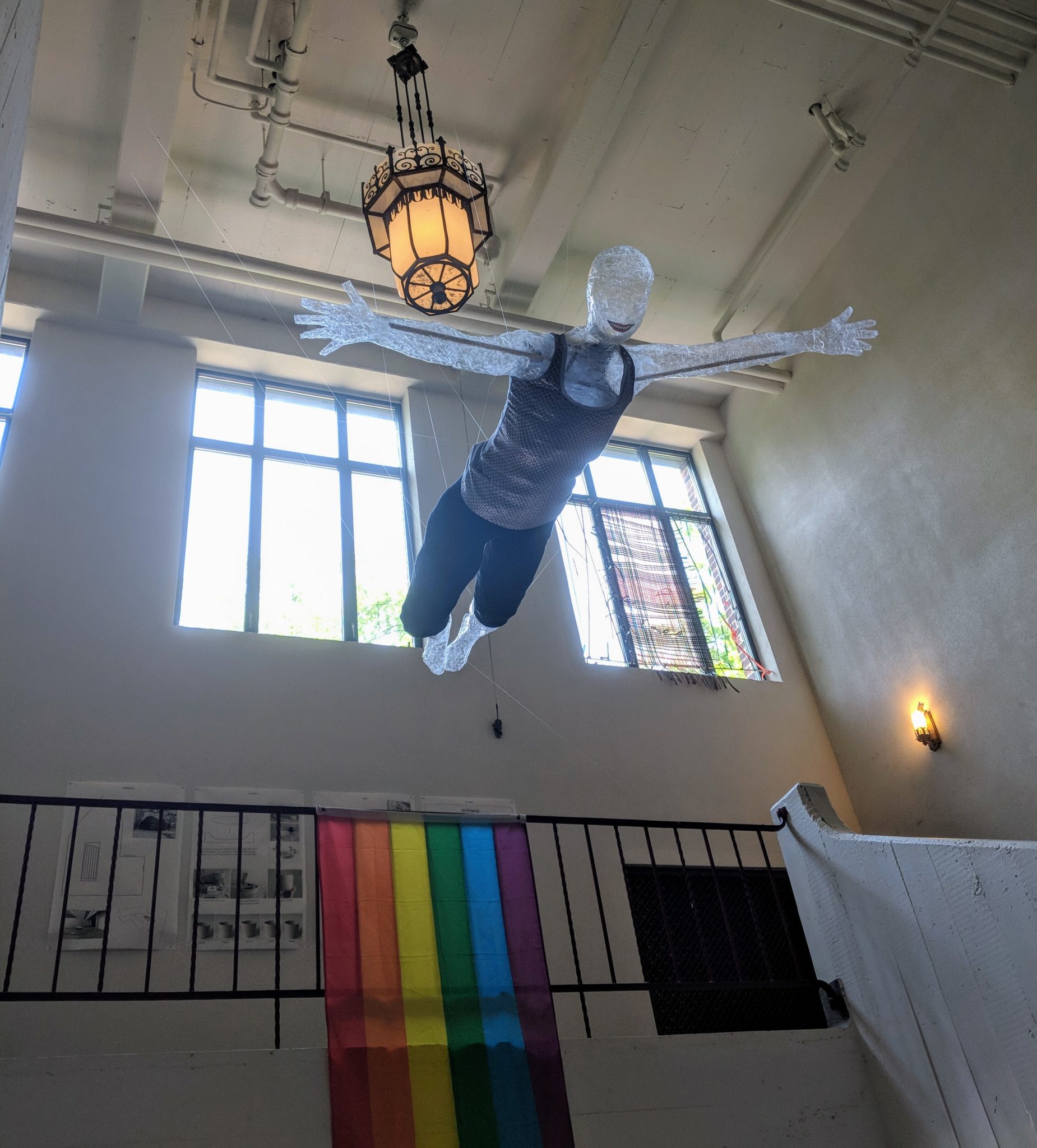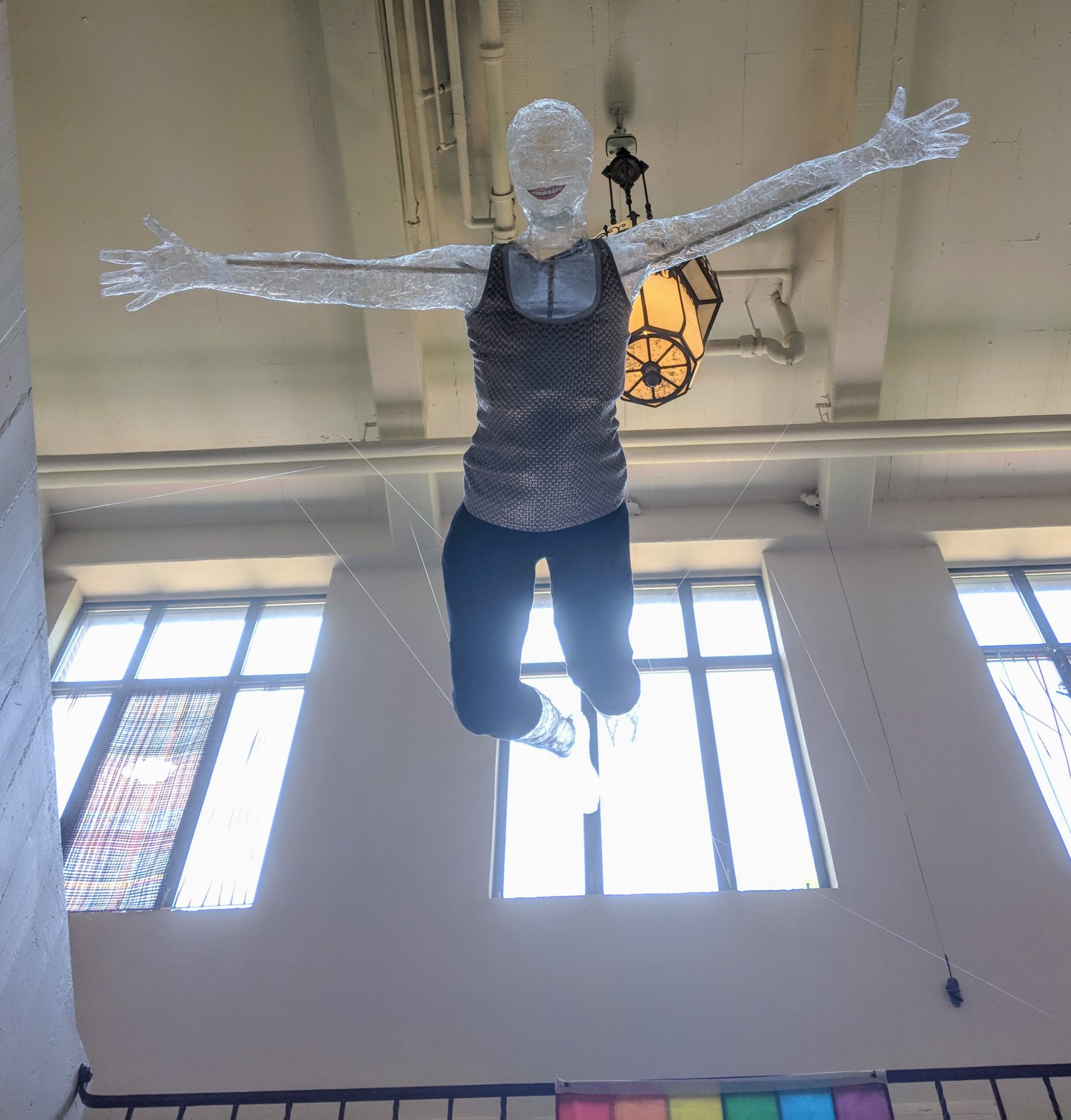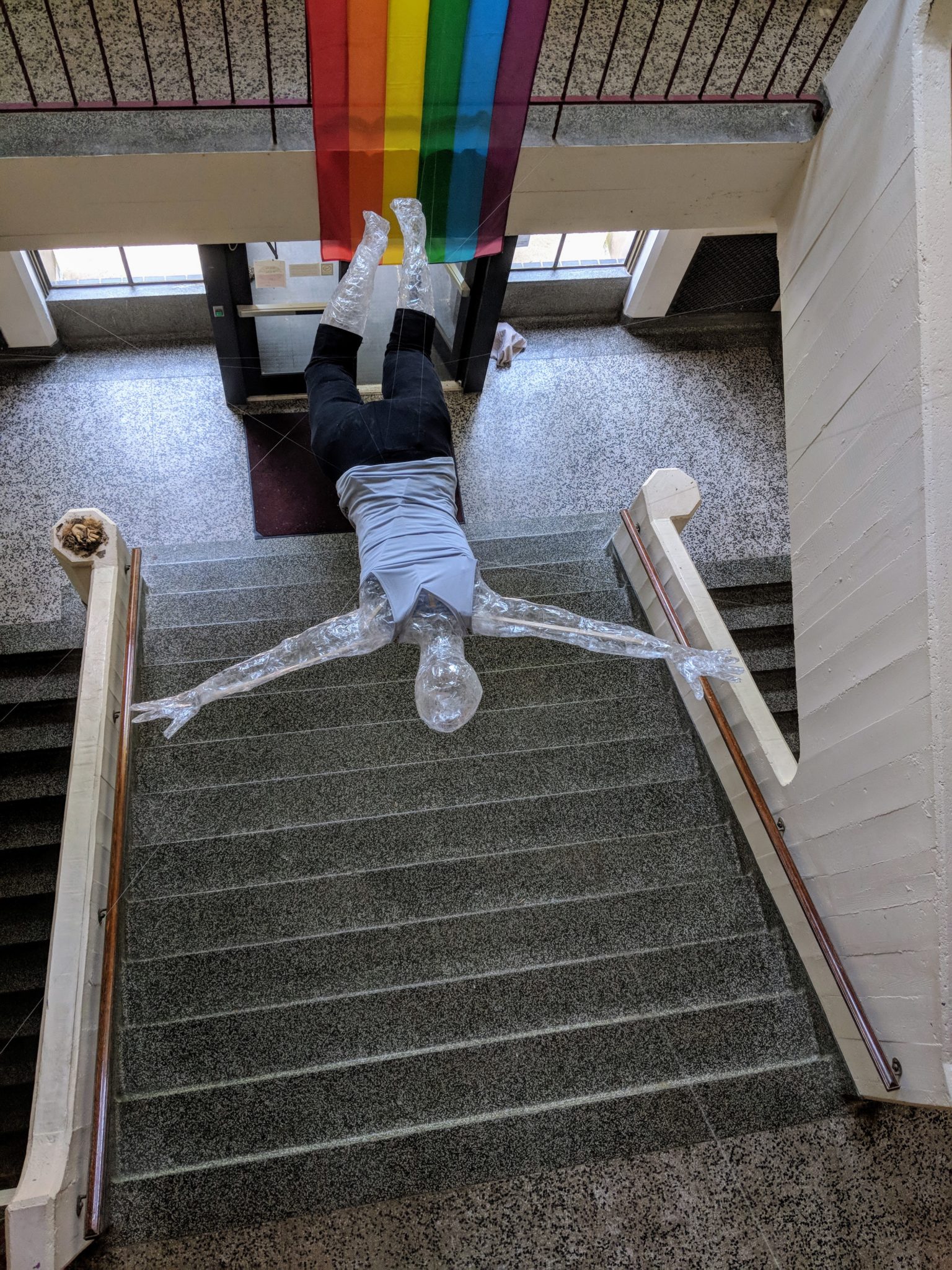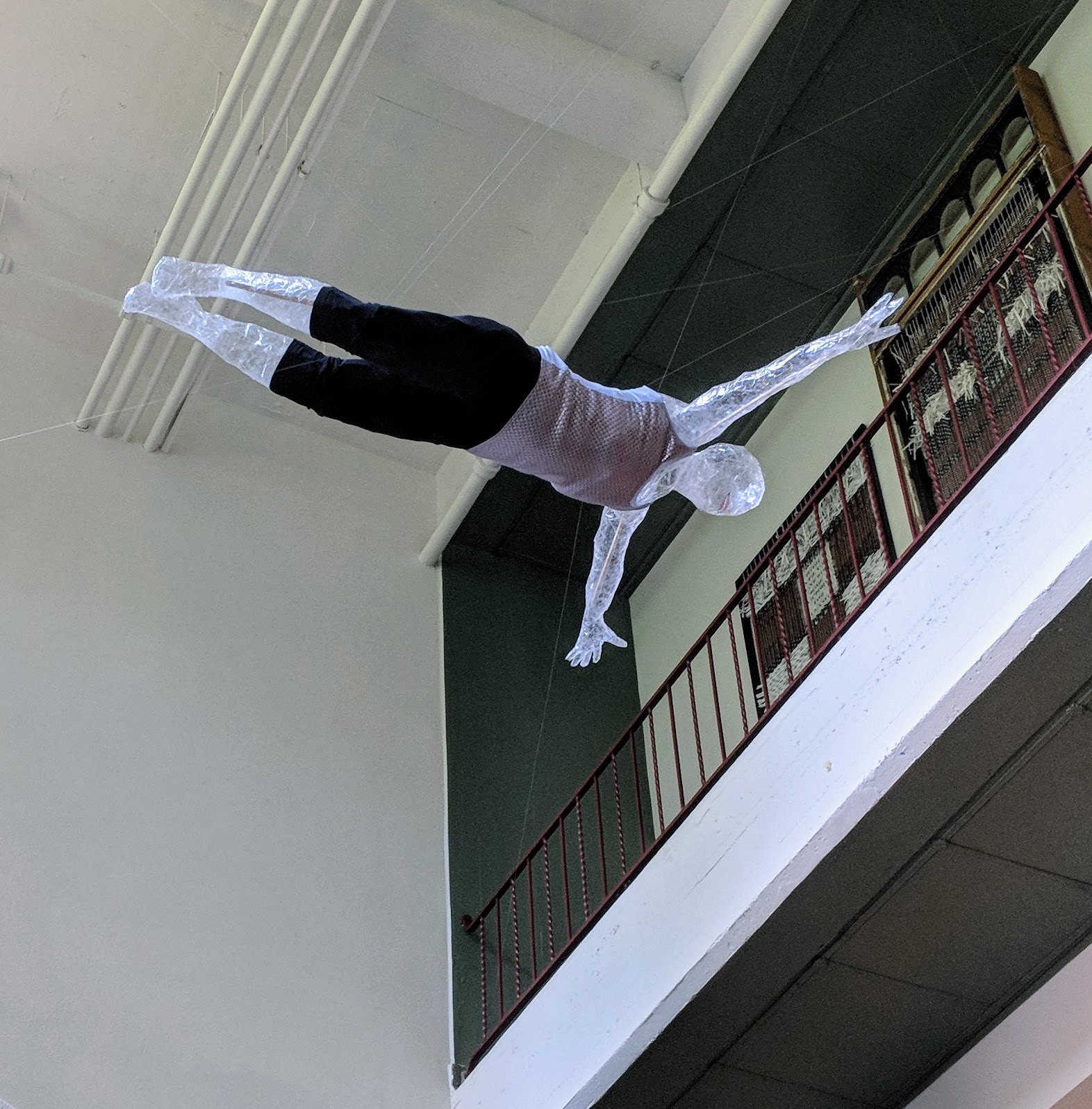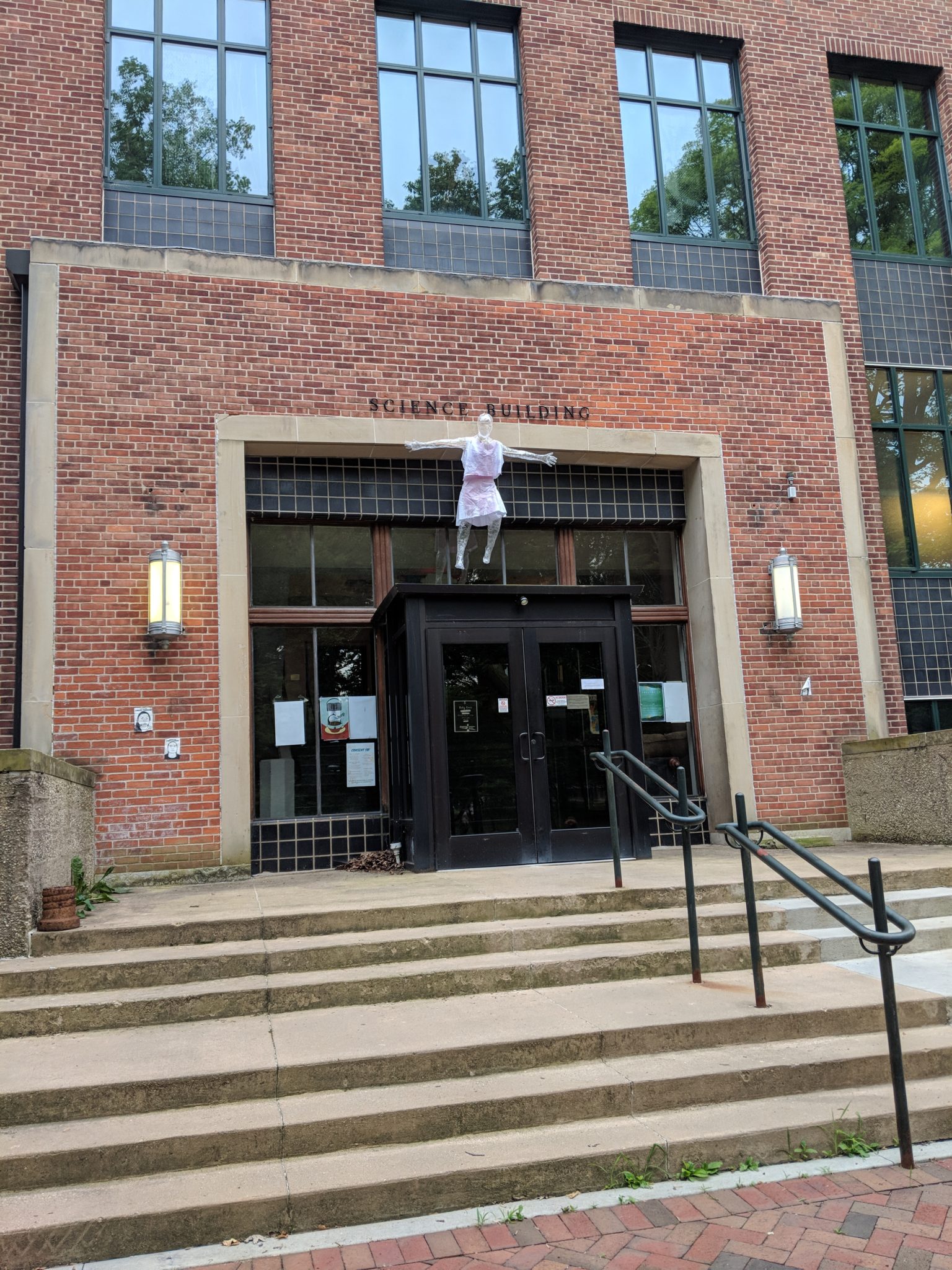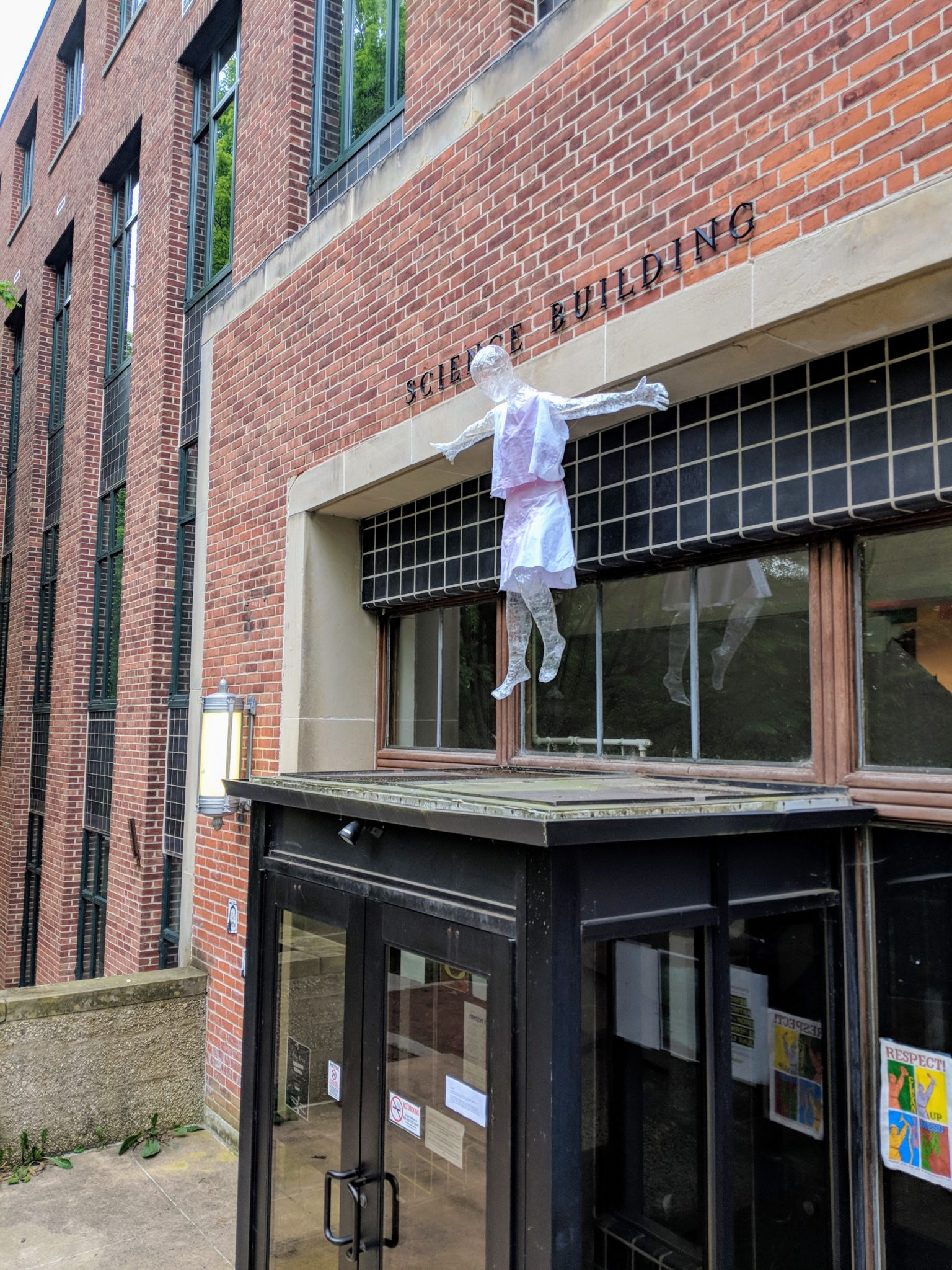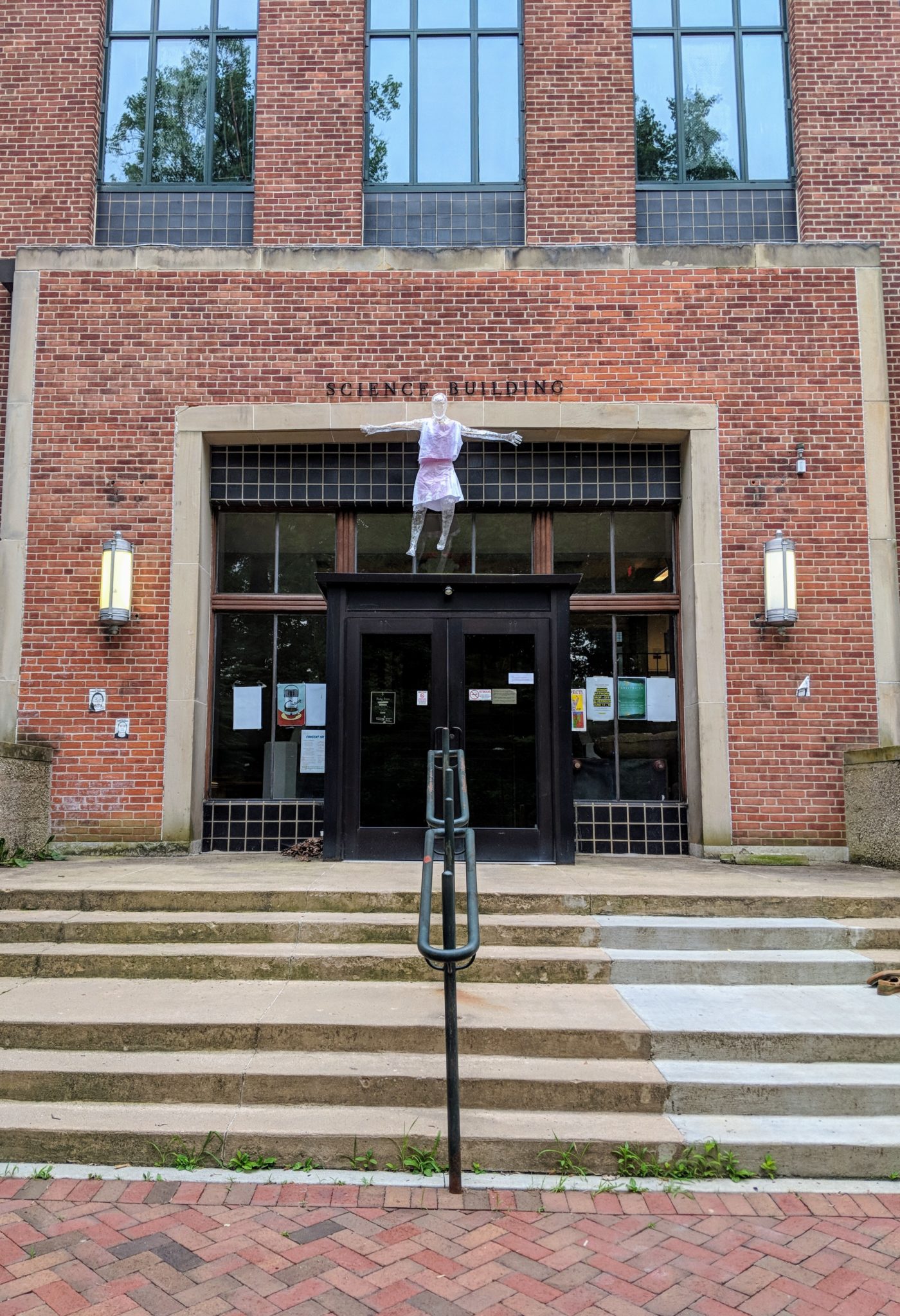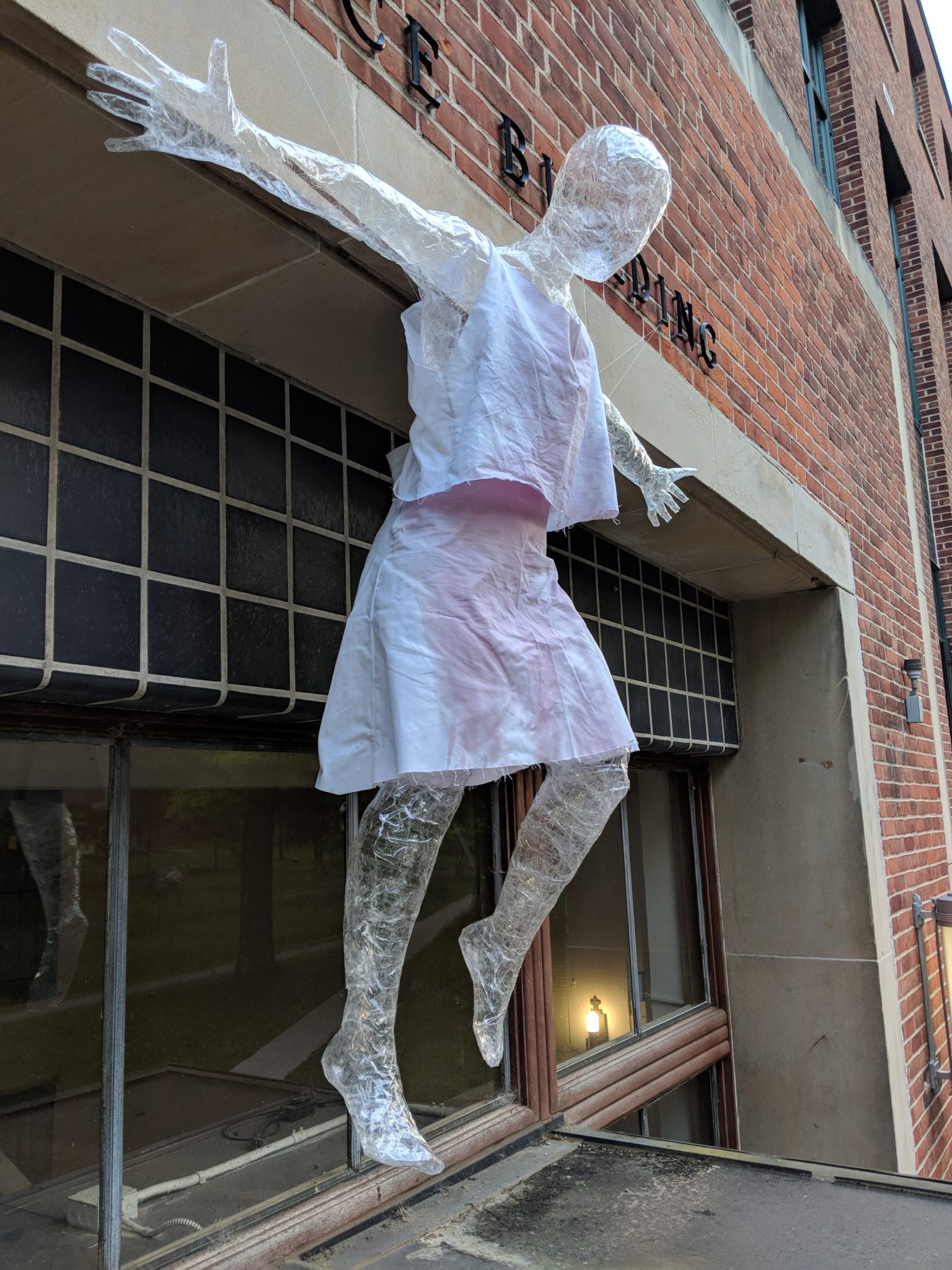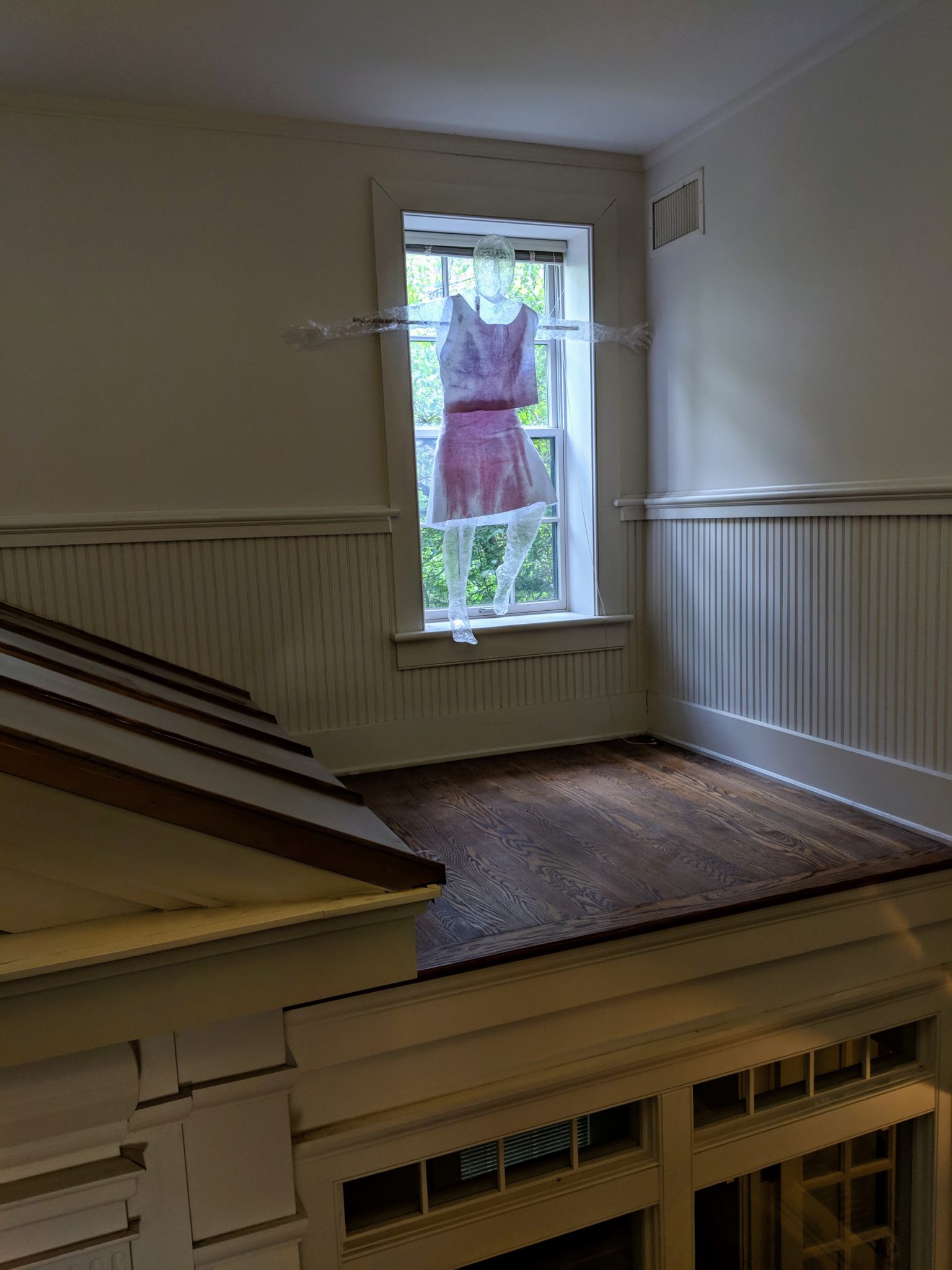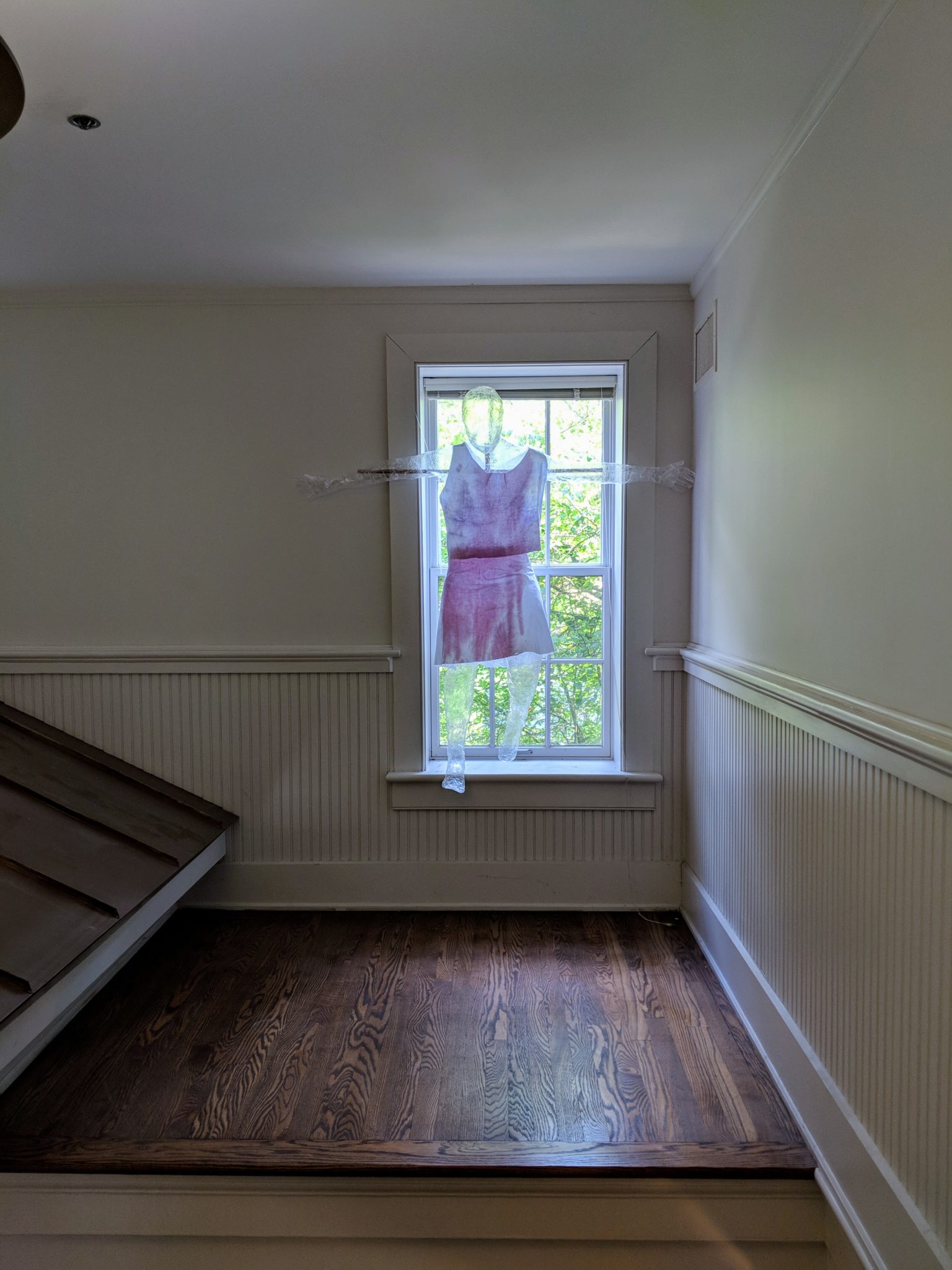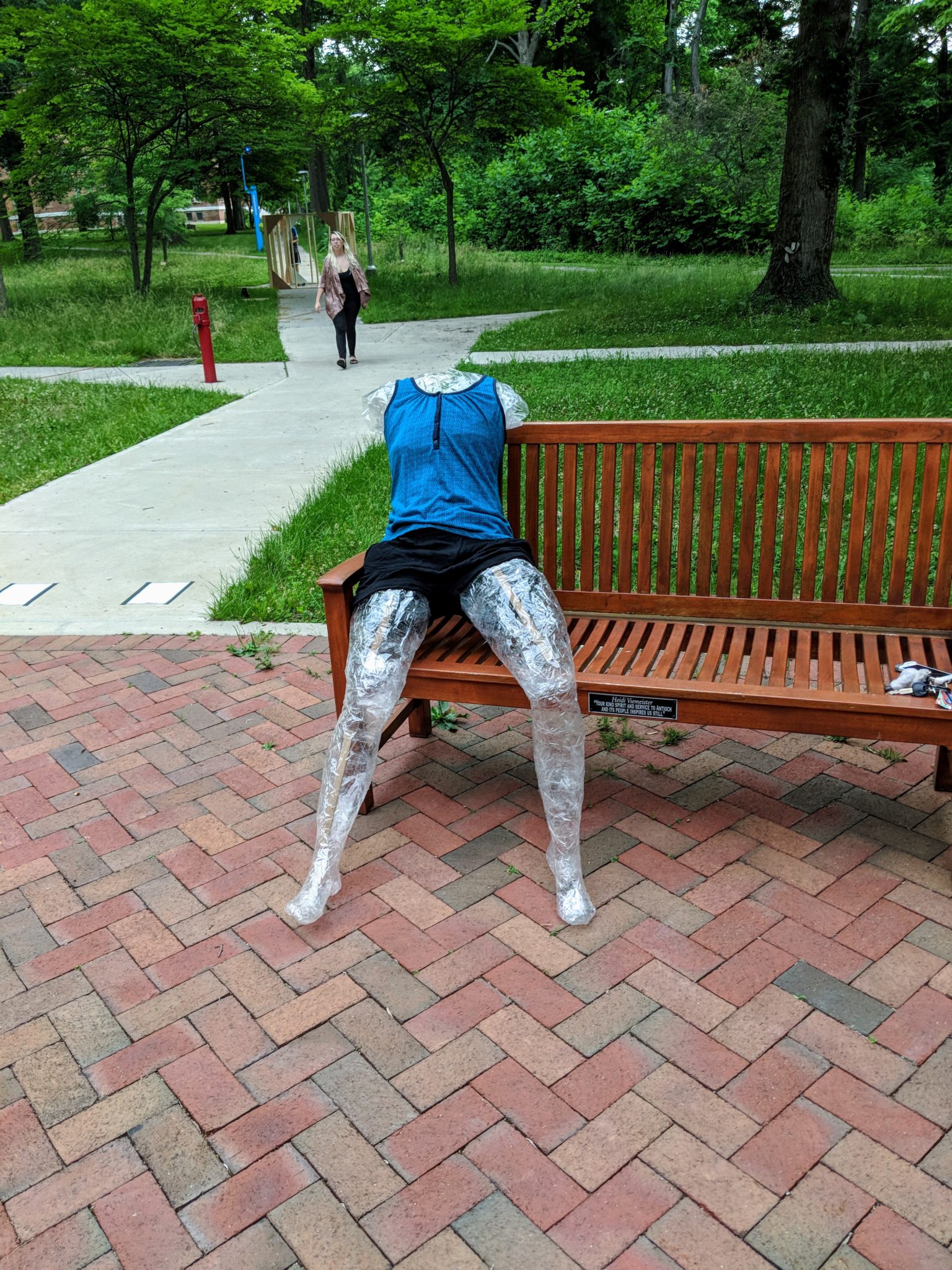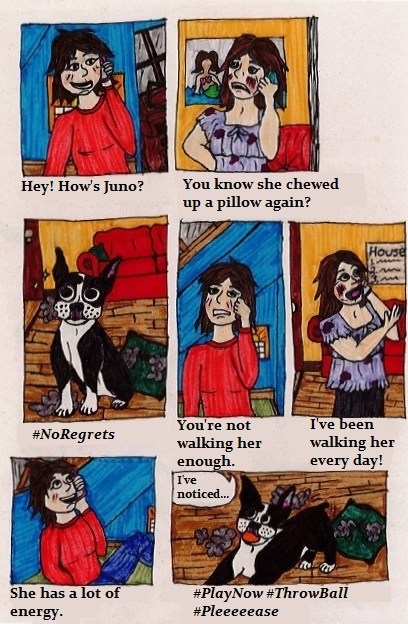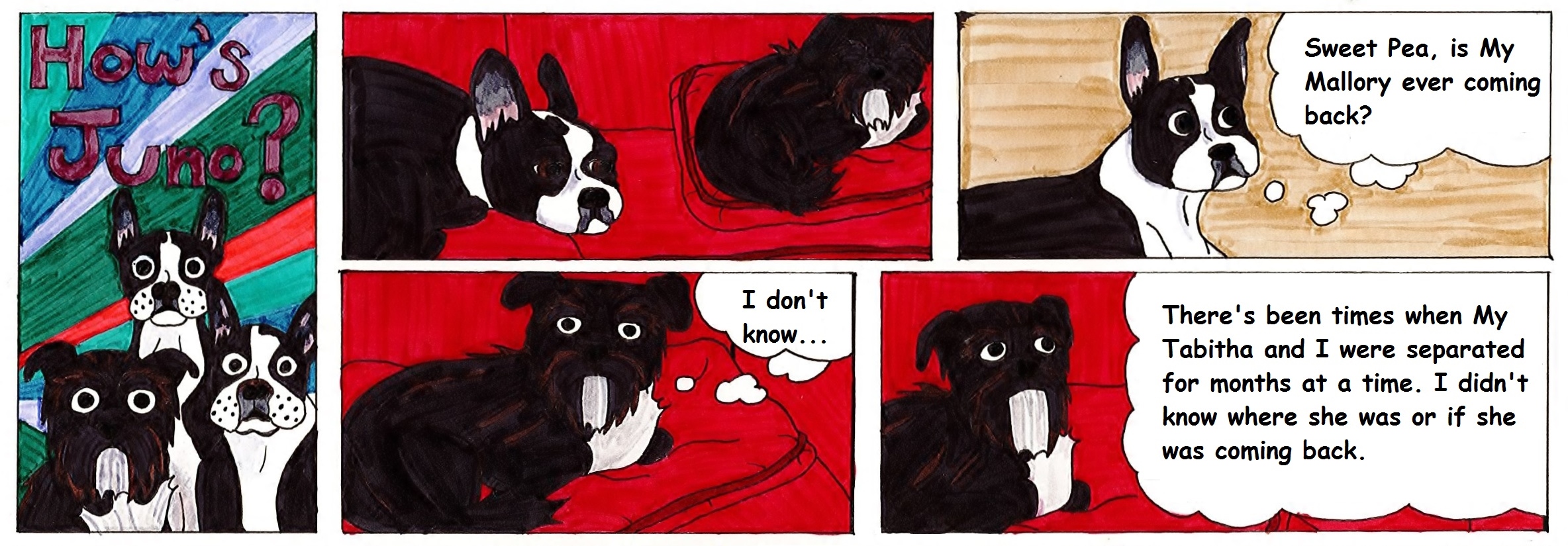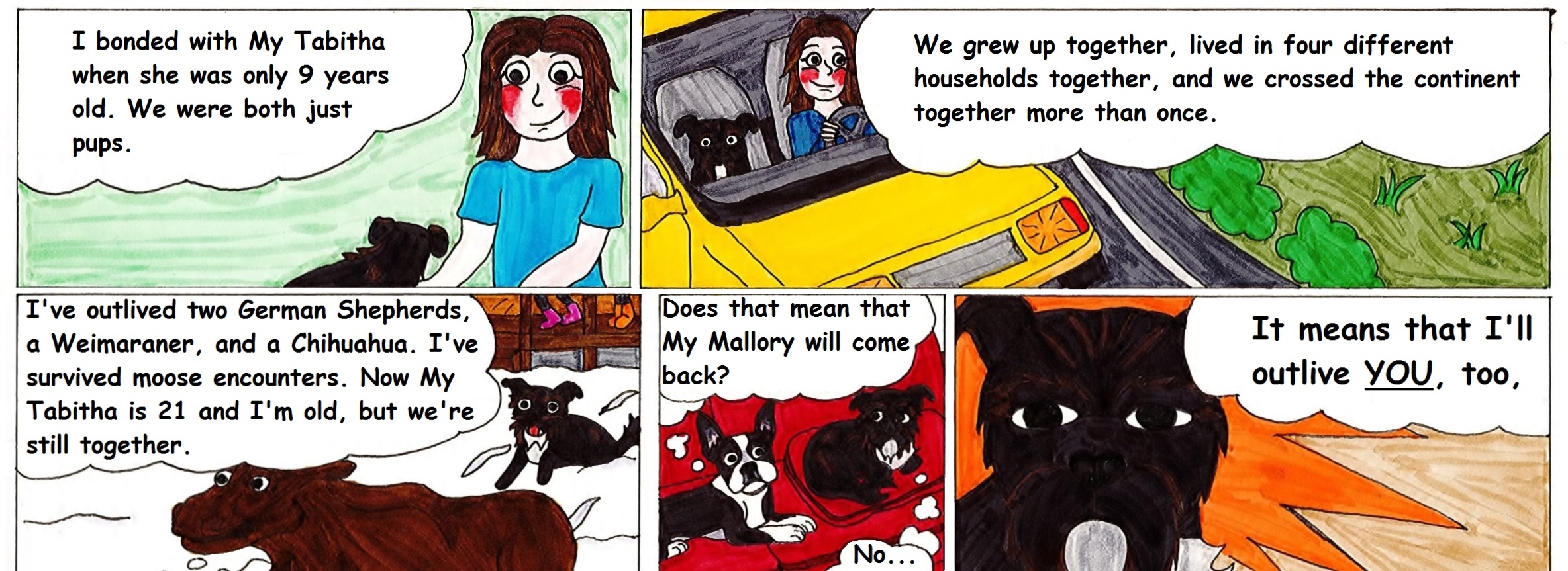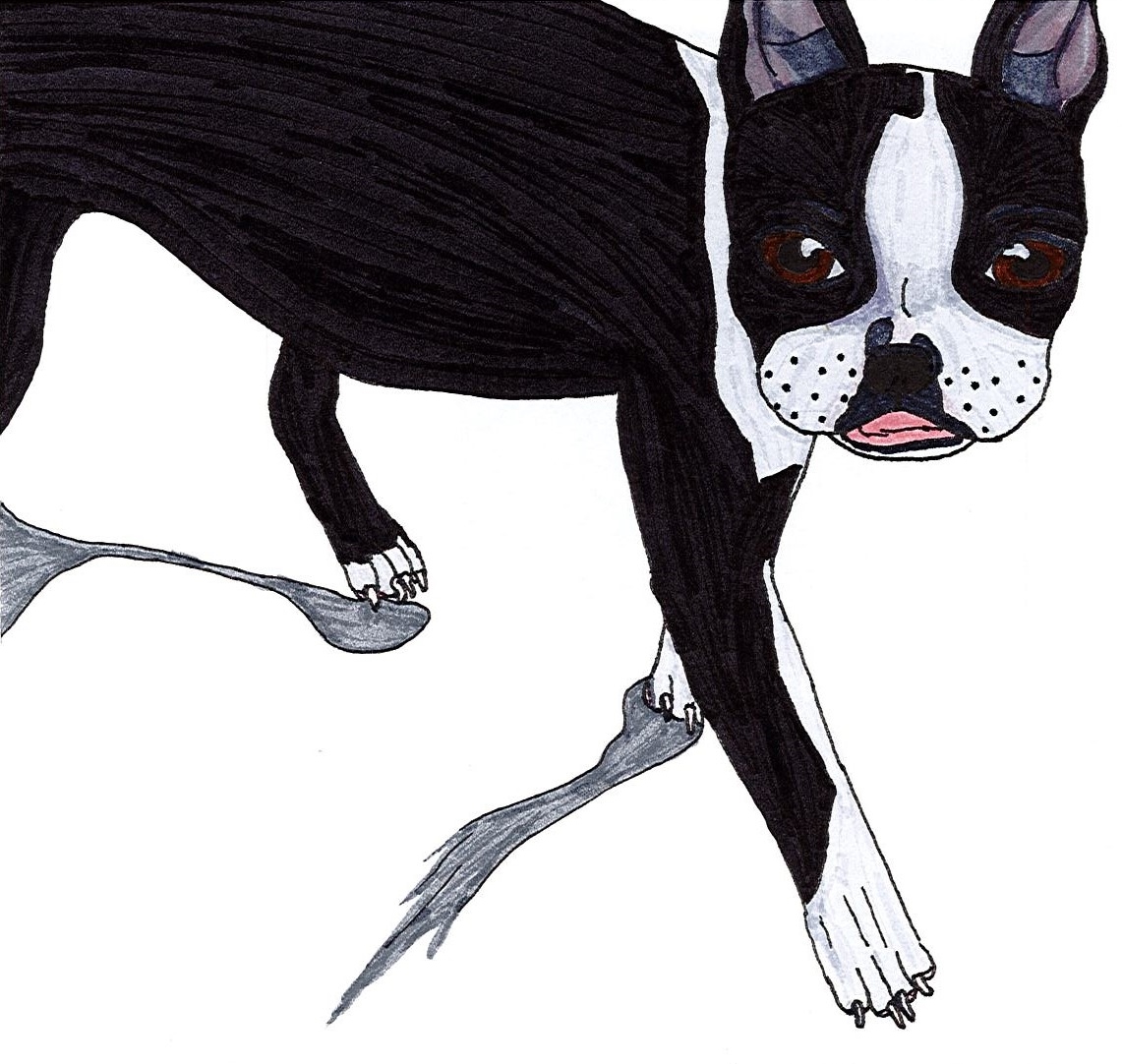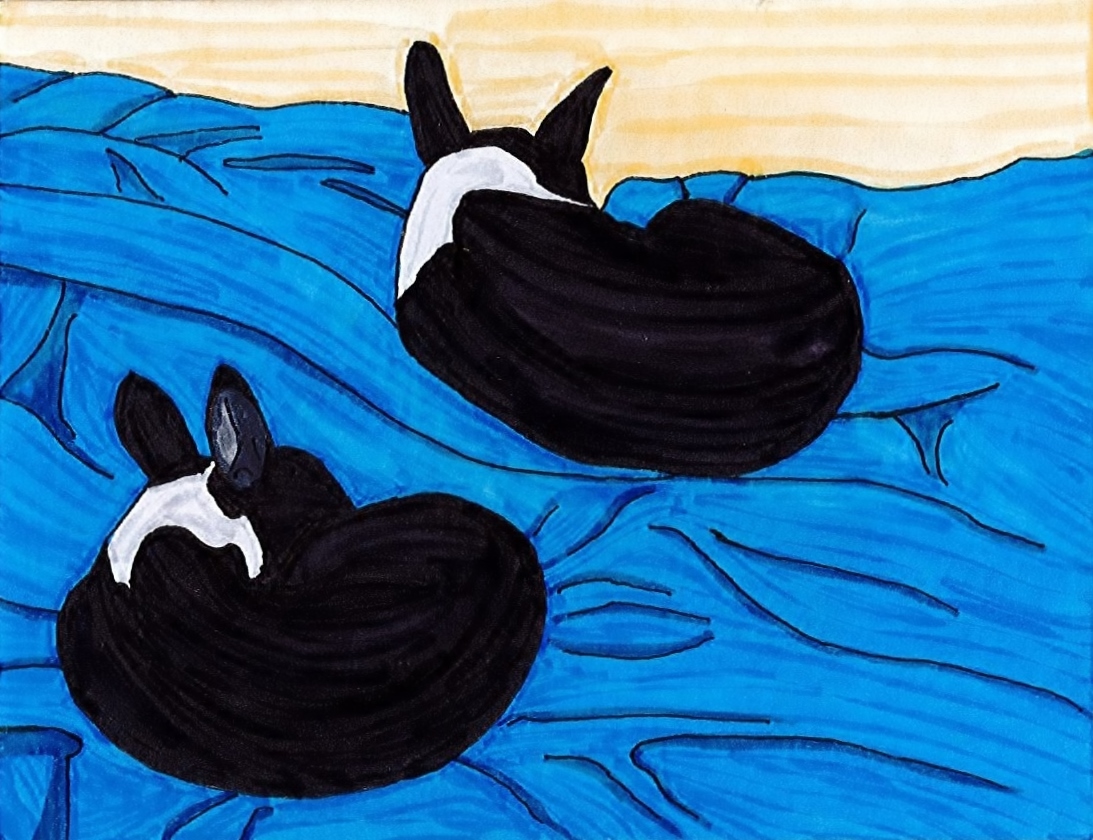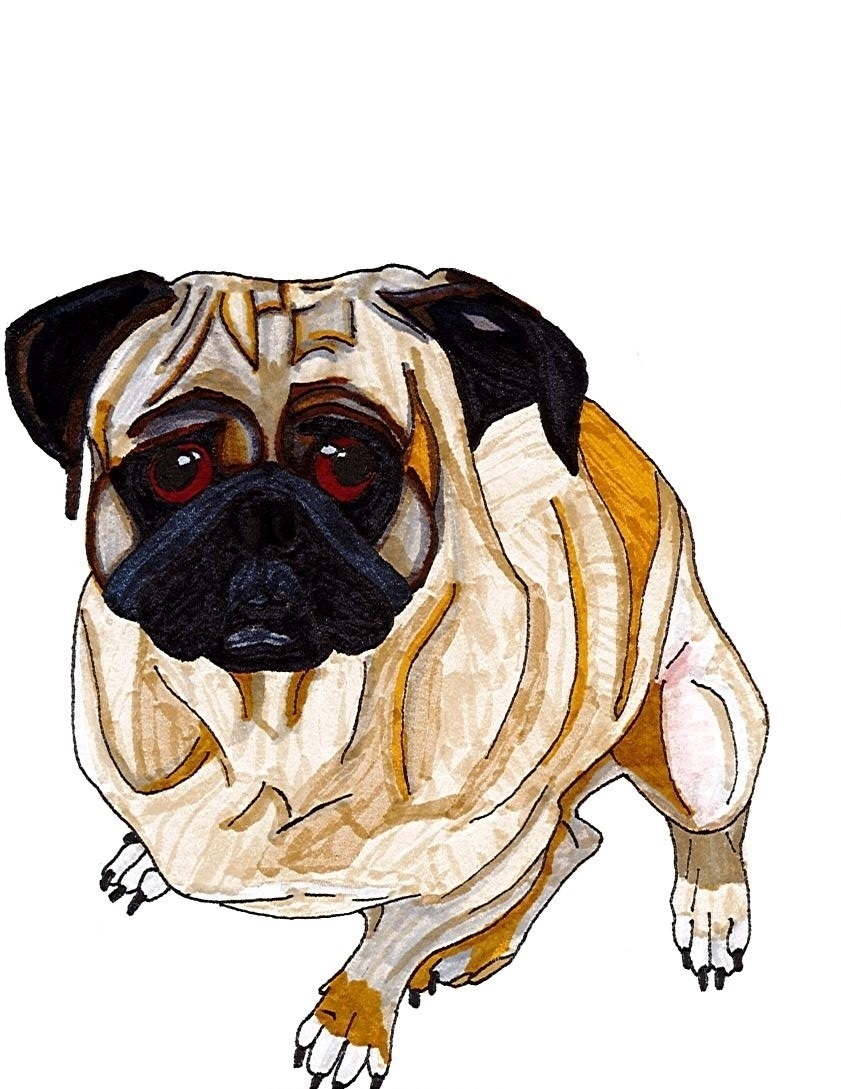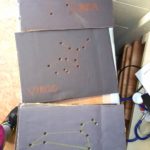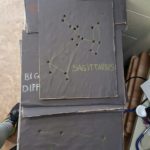My Return as a Children’s Community Art Teacher: Drover ’19 at the Homer Art and Frame Co. in Alaska
Mar 06, 2019I arrived in Homer, Alaska two weeks early for the summer quarter. Knowing that the quarter would only last five and a half weeks (07/08 – 08/14), I decided to be proactive and make the most of my time in the land of the midnight sun.
On Tuesday, June 26th I met with Lynda Reed at her business, the Homer Art and Frame Co. It was the same day I arrived in Alaska. We discussed plans for my work as children’s community art teacher which included age groups, scheduling, curriculum, and supplies. I taught my first class on July 2nd, the following Monday.
Lynda’s shop has the widest selection of art supplies in Homer. At the back of the Homer Art and Frame is a classroom where Lynda hosts various art classes each week. The mission of the Homer Art and Frame “is to support the artistic endeavors of our community by offering a wide array of art supplies for the novice, student or professional, and to provide art instruction that unleashes the creative spirit in all of us.”
By the time the quarter officially began I had already established my curriculum schedule and taught four art lessons in Lynda’s classroom over two weeks. On Mondays from 2pm-3:30pm I teach children ages five to eight years old. At the same time on Tuesdays I teach children ages nine to twelve. Below is the schedule I constructed with Lynda for the seven weeks of my classes.


Credit to Lynda Reed for this official advertisement of my children’s art classes, taken from Homer Art and Frame Co.’s schedule page.
This is not the first time that Lynda has hosted me as a teacher in her store. My first foray as a children’s art teacher in Homer occurred during my third co-op in the fall quarter of 2017 (08/05/17 – 12/22/17). The original plan for my third co-op had to be changed at the last minute due to illness. I caught pneumonia in August of 2017, and still hadn’t recovered two months later as the start date of my third co-op approached. Instead of staying in Yellow Springs, I decided to return home to Alaska for my co-op. My priorities were to rest, heal, and breathe plenty of the clean ocean air. However, the abrupt change of plans meant that I was scrambling for work as the quarter began. On the first Friday of October I was introduced to Lynda by an old friend from Ptarmagin Arts, the cooperative owned art gallery of which I used to be a member, while attending the various art shows around town. It was suggested that I could teach a few holiday art classes for kids through the Homer Art and Frame Co. Lynda and I exchanged information, and she explained that she’d found a shortage of community art teachers interested in working with children. Lynda helped me plan a series of eight weekly classes titled “Kids Crafting With Magical Mallory.” The experience was a great success. I was approached regularly by community members asking about the classes and informing me of positive feedback from parents and their kids. One of my favorite moments during these classes was on December 14th when my students asked me whether I’d be teaching more classes in January after the holidays. I explained that I would have to return to my college in Ohio, and the room filled with groans and boos of dismay. I was asked the same question by two different parents as they picked up their kids that day, and met with similar disappointment that I wouldn’t be around in January.
Frame Co. Lynda and I exchanged information, and she explained that she’d found a shortage of community art teachers interested in working with children. Lynda helped me plan a series of eight weekly classes titled “Kids Crafting With Magical Mallory.” The experience was a great success. I was approached regularly by community members asking about the classes and informing me of positive feedback from parents and their kids. One of my favorite moments during these classes was on December 14th when my students asked me whether I’d be teaching more classes in January after the holidays. I explained that I would have to return to my college in Ohio, and the room filled with groans and boos of dismay. I was asked the same question by two different parents as they picked up their kids that day, and met with similar disappointment that I wouldn’t be around in January.

Photo credit to Lynda Reed, both taken on 11/16/17 while I taught in the classroom of the Homer Art and Frame Co.
I suppose it should be no surprise that working with children has come so easily to me given my first co-op with the YSCCC, which also included elements of art and teaching. The teaching work in my third co-op lead to good opportunities for my fourth co-op, including an established environment and a base of return students. I was able to expand from teaching one wide age range to two narrower ranges, which enabled me to develop curriculum which better targeted the abilities of each. While the classes I taught in my third co-op were comprised mostly of three-dimensional arts and crafts activities, my lessons this co-op have been based in two-dimensional concepts used for drawing and painting. I’m especially excited to work with the older group on drawing perspective over the next couple of weeks.
Many people have been asking me what I plan to do after I graduate from Antioch College. My answer always begins with a hesitation and a stutter, but as I look back now I realize that I’ve navigated toward work with children in three out of my four co-ops. I’m still certain that a full-time teaching position is not what I want for myself in the long run, even teaching art. However, it seems that work with children will be a natural part of my future.
Fashion Crimes: The Rabbit Hole of Criminalized Cross-Dressing in US History: Drover ’19 at Boston MFA in Boston, MA
Mar 26, 2017Perhaps my favorite take-away from my co-op with the MFA Boston is the beginnings of a research project. In the last few weeks of my winter quarter, I’ve begun constructing a timeline of arrests, laws, and court cases which target cross-dressing through US history. It has steadily become one of the most engrossing projects I’ve ever started.
While conducting research for an exhibit on gender-bending and fashion (which I talked about in a previous post) I began to look into cases in which women had been arrested for wearing pants. Michelle Finamore recently published an article, The Audacity of Pants, which touches on the cultural shifts that took place in America with the simple action of women donning trousers. She considered the subject through the lens of women’s appearances in formal tuxedo wear under the Hollywood spotlight, from women such as Marlene Dietrich in her iconic Le Smoking suit to Barbra Streisand making history when she became the first woman to wear a formal suit to the Oscars.
For Streisand, while the press was never that explicit about the pants being the issue, there was an undercurrent of disapproval in some of the coverage. A number of journalists referred to it as pajamas, suggesting an informality that was simply not appropriate for evening wear. Even now, amidst the seemingly endless award shows, the Academy Awards are still arguably the most visible platform for Hollywood fashion display. –The Audacity of Pants
Well before Hollywood began to showcase icons such as Dietrich or Josephine Baker, both of whom would challenge the traditional gender narrative through their choice of performance clothing, the path to their liberating attire had to be paved by women whose lives were far from the spotlight of entertainment and glamour. At the start of my research, the first example of a woman in the US being arrested for wearing pants that I could immediately recall was the case of Helen Hulick in 1938. Hulick was held in contempt of court and sentenced to jail for five days when she refused to follow a judge’s orders to wear a dress when she appeared to testify against two suspected burglers. She only served one hour of her 5-day sentence, and returned to court in a dress months later. While Hulick is a recent example of a woman being sent to jail for wearing pants, the earliest example I’ve found (yet) was a young woman by the name of Emma Snodgrass, who was arrested multiple times for publicly wearing pants in 1852 and ’53.
Snodgrass’s timeline has been a bit of a challenge for me to piece together, but from what I can tell she was arrested in Boston on November 30th of 1852 for what seemed to have been the second time that month, for traveling in the city while wearing pants and other masculine-style clothing. She was seen at a museum prior to her arrest “sporting a model cane, Kossuth hat, frock coat, pants, &c., not to mention an ambitious shirt-collar and flaming scarf.” It would appear that in the case of both arrests, she was simply sent home to her father in feminine attire. She was arrested again on December 28th and brought to court on charges of vagrancy the next day, which the judge dismissed. She was arrested again on December 31st, along with a companion by the name of Harriet Finch, who “sported a Kossuth hat, shiny gaiters, model cane, black pants coat,” and had been using male pseudonyms. It was later reported on January 10th that Harriet “was sentenced to the House of Reformation for six months. This was afterwards so qualified as to permit her twenty-four hours to leave the city -which she promised to do.” One of the last sightings of Emma Snodgrass was reported by The Daily Dispatch, which said she’d been spotted in Albany while registering her name as “Henry Lewis,” and that she claimed to be traveling to either California or Australia.
The New England Historical Society article on Snodgrass lists her travels in greater detail, but I hesitate to use their primary source. Unfortunately, the compilation of articles by Will Johnson no longer link back to his sources, and not even the link attached to his name as the author is functional. For now I’ve compiled as many original source accounts of Snodgrass as I can currently access, and I plan to see what else I can find through Antioch’s resources once I’m back in Yellow Springs for the spring quarter.
Yet far more impressive than Snodgrass’s persistent public appearances is the earliest example I’ve found (yet) of a woman breaking the law by wearing pants, which took place just four years prior with the incredible case of Ellen Craft in 1848.
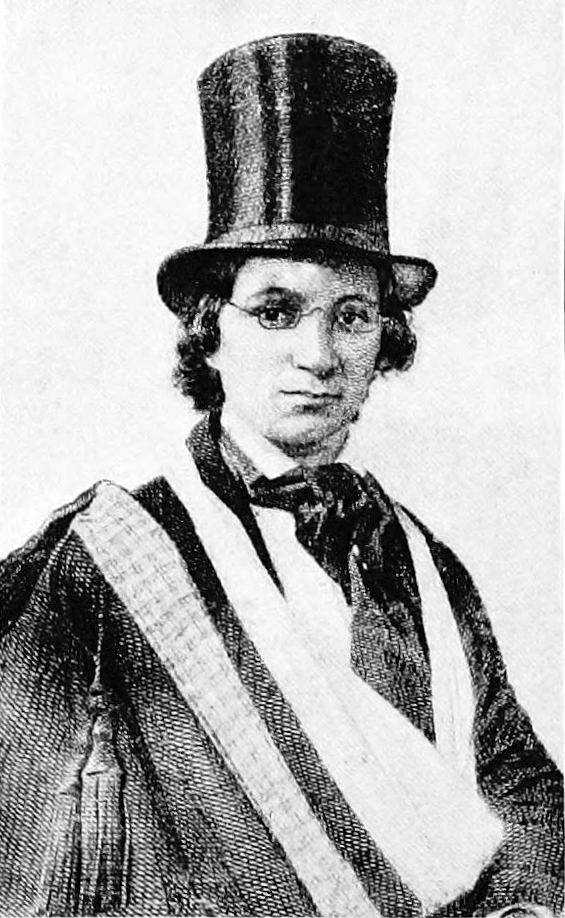
Ellen Craft, Public Domain, Link
Ellen and her husband, William Craft, were both slaves in Macon, Georgia. In December of 1848, they were able to make their terrifying escape to freedom thanks to Ellen’s gender-bending portrayal as a white man traveling with his loyal attending slave (William). They traveled from Macon to Philadelphia over the course of four days. Ellen’s father had been a white slave owner, and her skin was so fair that she was sometimes mistaken for a member of the white household. It was William’s idea for Ellen to disguise herself. They cut her hair, she put on pants that she’d made herself, and she wore a top hat and spectacles. They wrapped bandages around her face to cover her lack of facial hair, and put her right arm in a sling so that she wouldn’t be expected to sign her name along the way (as neither Ellen or William were literate). During their travel she sometimes also pretended to be disabled.
Pondering various escape plans, William, knowing that slaveholders could take their slaves to any state, slave or free, hit upon the idea of fair-complexioned Ellen passing herself off as his master—a wealthy young white man because it was not customary for women to travel with male servants. –The Great Escape From Slavery of Ellen and William Craft
This particular example also sheds light on what might be the most significant root of the systemic targeting of cross-dressers by authorities in our country: racism. In the book, Whitewashing America: Material Culture and Race in the Antebellum Imagination, author Bridget Heneghan points out on page 116 that opponents of the Bloomerist movement sometimes attacked the femininity of bloomer-wearers by comparing their clothing to slave garb, or other clothes associated with African American women. Peter Boag describes in his book, Re-Dressing America’s Frontier Past, that cross-dressing accounts in the 19th and 20th century West usually recorded the person’s race unless they were white, and often in derogatory or slanderous terms.
Only one source that I came across referred to a white male-to-female cross-dresser’s race. Significantly, the newspaper that divulged this identity did so for the purposes of questioning that individual’s character because he otherwise associated with African Americans: in 1897, Topeka, Kansas, police arrested a twenty-six-year-old resident female impersonator known only as “LeCroft,” for dressing up in women’s clothing to rob men. The paper reporting the incident described LeCroft as “a white man who lives with negroes … and had traveled with minstrel company.” (Boag)
Boag follows with multiple examples of the narrative which followed individuals of color arrested for cross-dressing, including how the narrative would change once it was realized that those individuals weren’t white. Like Heneghan, Boag also identifies how women of color in particular were stripped of their feminine identities. The book U.S. Women’s History: Untangling the Threads of Sisterhood, a collection of essays by multiple authors, also confirms the persecution of black womanhood, and identifies the necessity of black women to disguise themselves in men’s clothing, because the mobility of black slave women was even more controlled and criminalized than their male counterparts. Enslaved men could travel more easily than enslaved women in general, and could therefore escape more easily. U.S. Women’s History is the resource that brought my attention to the example of Ellen Craft, and the necessity for her to pass not only as a man, but as a white man.
The ability to pass as white was crucial to Ellen’s gender crossing –for whiteness was the key to the privileges of manhood that so many women sought. […The Crafts’] path to freedom was no Underground Railroad. Rather, it followed a course that accessed the privileges and freedoms of white manhood. –U.S. Women’s History: Untangling the Threads of Sisterhood

Harriet Tubman sometimes dressed as a man, one of the numerous methods of disguise she used to help slaves escape to freedom. Public Domain, Link
Cross-dressing as a tactic of disguise for run-away slaves likely aided the growing paranoia by authorities that women wearing pants or men wearing skirts were people attempting to trick others and hide their true identities for nefarious reasons. Ruthann Robson, in her book Dressing Constitutionally: Hierarchy, Sexuality, and Democracy from Our Hairstyles to Our Shoes, makes the connection between cross-dressing and the rise of vagrancy arrests, as the fear of disguise (63). Originally in response to the anti-rent riots, New York passed an anti-vagrancy statute in 1845 which defined a vagrant as “Every person who, having his face painted, discolored, covered or concealed, or being otherwise disguised, in a manner calculated to prevent him from being identified, shall appear in any road or public highway, or in any field, lot, wood or inclosure, may be pursued and arrested” under section five. For over a century after it was passed, this New York vagrancy statute has been repeatedly used to target cross-dressers, on the basis that their clothing acted as a “disguise” of their true identities. Examples include the arrests of Jenny F. Westbrook in 1882 and 1883 (whose case is also detailed in the work of author Carol Mattingly, whom I introduce below), the case of the People v. Luechini in 1912, and the case of the People v. Archibald in 1968.
Included in the list of cross-dressers charged with vagrancy is also Emma Snodgrass, whose charges were said to be dismissed because her “male attire” was “really little or no disguise, her form being so light and fragile, and her feature and manners so entirely feminine,” and because she had too much money to be a vagrant. Heneghan hints toward the link of classist implications of enforced gender-norms and dress which tie into the sentiments of racism (“the paucity of dress suffered by slaves,” 116). Heneghan also references the newspaper accounts of Emma Snodgrass and the analysis of the “contradictory” language in those articles by Mattingly.
Carol Mattingly is the author of Appropriate[ing] Dress: Women’s Rhetorical Style in Nineteenth-Century America. In chapter 4 of her book, “The Language of Passing and Desire: The Rhetoric of Cross-Dressing,” Mattingly examines several examples of arrested “proper” women cross-dressers being released into the custody of a man (usually their father, husband, or brother) with only a warning.
For the most part, women who thus appeared in men’s clothing could be treated kindly and in good humor if the breech in decorum appeared to be a solitary lark. If women feigned modesty, authorities simply reprimanded them. In one reported case, the cross-dresser resorted to a display of femininity; she was accompanied by a man, conducted herself “with propriety,” confessed her transgression, and pleaded with the official in charge to protect her anonymity -all acceptable feminine behavior. Such women were generally dismissed into the care of their escorts[…]” (Mattingly, 102)
Mattingly states that the primary reason that Snodgrass dodged a prison sentence was because her father was an officer with the New York Police Department, meaning that her class status got her out of trouble. Mattingly also makes this connection with the example of Dr. Mary Walker, although she also describes how this effect wore off as Dr. Walker aged and lost her impression of femininity over time.

Dr. Mary Walker, 1912, image via the Library of Congress.
Dr. Walker has become my personal absolute favorite example of criminalized cross-dressers. Just from what I’ve found so far through the Library of Congress newspaper archive, Chronicalling America, Dr. Walker was arrested on seven separate occasions for wearing pants- eight occasions if you count an arrest in 1874 over a dispute with her tenant, which the Chicago Daily Tribune interestingly suggests might not have happened if she’d maintained her assumed “masculine” authority of wearing pants without the compromise of a skirt over top of them, which discredited her as a “badge of feminine servitude.” She was arrested New York in 1866, in Kansas City in 1869, threatened with arrest in New Orleans in 1870, arrested in Baltimore in 1873, seems to have been arrested in Brooklyn at some point, was arrested again in New York in 1878, arrested in Providence in 1886, and arrested in Chicago in 1913 at the age of 80-years-old. Dr. Walker wore pants under her skirt and a man’s coat to her wedding in 1856 (and refused to take her husband’s last name, as well as omitting “to obey” from her vows). Most impressively, she is the only woman to this day to have been awarded the Congressional Medal of Honor, which she received for her part as a surgeon in the American Civil War. During the war she wore a modified version of the male Union uniform, and refused to wear the women’s clothing provided for her after she was taken prisoner by the Confederates. Dr. Walker was also awarded the right to wear men’s clothing by an act of congress after the war. After her death in 1919 at the age of 87, Dr. Walker was buried in one of her suits. In 1982, the US Post Office issued a stamp in her honor, but interestingly the chosen image for the stamp is uncharacteristically lacy and feminine for Dr. Walker.
Sorting through all of these resources, reading these stories of perseverance in the face of oppression, the dialogues and analysis of gender and personal identity, examining the root reasons for which both state and federal authorities believe it to be in their best interests to enforce the binary concept of strictly male or female gender, I feel as though I’ve tumbled down a perpetual rabbit hole of historical insight. Suddenly I’ve begun to recognize the repetitive nature of the human condition across time, and how similar the events happening today really are when compared to the events of the past. Part of the reason Michelle Finamore first dove into the idea of fashion and gender-bending as the makings of an exhibit is because of how this issue has come to the forefront of our cultural dialogue in recent years, especially as young people in the US grow bolder in exploring their identities outside of the constructed cookie-cutter notions expected of them. Exploring non-binary personal gender identity isn’t new. This blog post doesn’t begin to cover the extent of what I’ve found as I continue to tumble (I’ve barely mentioned examples from the 20th and 21st century!), but I’m going to continue researching and compiling information on this subject well after my co-op ends this week. I’ve promised Michelle that I’ll email her with new finds and updates to my timeline, and that I’ll try my hardest to come to her exhibit when it finally opens (likely not until December of 2018, at the earliest). I’m not sure what form this project will have taken by the time I’m through, but I’m excited to make it happen. For now, I’m calling this project Fashion Crime.
Below is a list of suggested reading if you’re interested in the topic of arrests, laws, and court cases which target individuals for cross dressing.
An Intimate Affair: Women, Lingerie, and Sexuality (book), by Jill Fields
Appropriate[ing] Dress: Women’s Rhetorical Style in Nineteenth-Century America (book), by Carol Mattingly
Arresting Dress: Cross-Dressing, Law, and Facination in Nineteenth-Century San Francisco (book), by Clare Sears
Beware the Masher: Sexual Harassment in American Public Places, 1880-1930, by Kerry Segrave
Dressing Constitutionally: Hierarchy, Sexuality, and Democracy from Our Hairstyles to Our Shoes (book), by Ruthan Robson
Re-Dressing America’s Frontier Past (book), by Peter Boag
Sexual Orientation, Gender Identity, and the Law in a Nutshell (book), by Ruth Colker
TransAntiquity: Cross-Dressing and Transgender Dynamics in the Ancient World (book), edited by Domitilla Campanile, Filippo Carla-Uhink, and Margherita Facella
U.S. Women’s History: Untangling the Threads of Sisterhood (book), by Leslie Brown, Jacqueline Castledine, and Annie Valk
When Everything Changed: The Amazing Journey of American Women from 1960 to the Present, by Gail Collins
Whitewashing America: Material Culture and Race in the Antebellum Imagination (book), by Bridget T. Heneghan
“Arresting dress: A timeline of anti-cross-dressing laws in the United States” (article/timeline), by PBS
“Challenging the Apartheid of the Closet: Establishing Conditions for Lesbian and Gay Intimacy, Nomos, and Citizenship, 1961-1981” (article), by William N. Eskridge Jr.
“Criminalized Crossdressing” (article), by David Duffield
“Dressed to Excess” (article), by Bill Manson
“#TBT: When Cross-Dressing Was a Crime” (article/book review), by Advocate
Research, New Discoveries, and Gender-Bending: Drover ’19 at Boston Museum of Fine Arts
Feb 21, 2017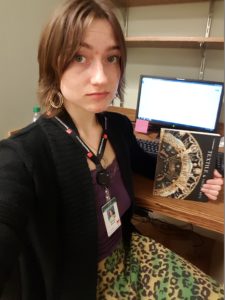
Myself, early on the job in my new office.
My internship with the Museum of Fine Arts Boston began on Monday, January 9th, in the Textiles and Fashion Arts Department. The primary focus of my time was going to be spent working with Michelle Finamore on a potential exhibit featuring fashion and gender-bending. The gender-bending exhibit, while in its very early stages, was what I looked forward to the most about my winter ‘17 co-op.
Now halfway through my co-op, I have been comfortably settled into my position and actively engaged with the project. The MFA’s mission is to conserve its diverse collections of art and artifacts, and to engage and educate visitors through a variety of learning styles and experiences. The MFA also seeks to identify and acquire new and under-recognized areas of art, and to gain cultural awareness and perspective.
Gender-bending as a subject is especially relevant right now thanks to recent social justice victories for the LGBTQ communities, the rise of transgender models in the fashion industry (and in popular shows such as Orange is the New Black), the growingly-mainstream discussions on modern feminism, the blurring divide
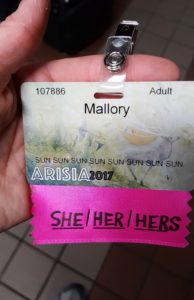
While attending ArisiaCon here in Boston, I discovered that the convention organizers had supplied pronoun ribbons to attach to our name-tags.
between men and women’s fashion even among celebrities, and the cultural shifts taking place among the millennial generation. Before I began working on the fashion and gender-bending exhibition, the subject of gender identity was already important to me. I explained to my co-workers on my first day that it’s customary at Antioch College to introduce yourself to others by your name and preferred gender pronouns. (When I restated this recently to MFA staffpeople from a different department, they blinked and asked me, “How does that even work?” I obliged with my personal example, “Hi, my name is Mallory. I go by she/her/hers.”)
Most of what I do for the project is research. I start my work day by checking in with Michelle. We touch base about recent research, possible new subject matter to pursue, and we come up with a general checklist of work that needs done or looked into. I spend time looking through books in our library, searching online archives and databases, updating our physical and computer files, and using The Museum System (TMS) to identify and organize the objects we’re hoping to include in the collection. At noon we break for lunch, and most of the TFA staff enjoy eating together at a big table in the department. It’s a cozy, relaxed environment where we can catch up, talk about our personal lives, and chat about new museum events. After lunch Michelle and I touch base again, refocus our goals for the day, and continue working. Often Michelle will invite me to sit in at multi-departmental meetings, which have served to give me a greater context for the work that the MFA does in conservation and restoration of museum objects, previews for upcoming exhibits or events, reviews of past exhibitions, and insights into other programs and general ongoings within the museum. This has been an indispensable resource for me to better understand the MFA, its mission, and examples of its work in action.
The research I’ve been conducting for the gender-bending exhibit has helped me learn new skills in not only collecting information, but also engaging with it. While going through the Vogue archives early into my co-op, I discovered a treasure trove of articles dating back to the 1890s that covered the concept gender roles, challenging gender stereotypes, discussions on feminism, and a number of other topics that I had previously believed to be unique to the modern generation. Who would have thought that I’d find an article concerning the self-assertiveness of women and their accomplishments which dates back to 1894? Or an article on men’s use of make-up from 1895? Or an article challenging the concept of the natural ‘maternal instinct’ within women, also from 1895? (I do wish I could share links to many of those articles, but access is not available to the public.) I’ve been learning how to recognize and follow the connections and influences across time to the point that we’ve reached in today’s culture,
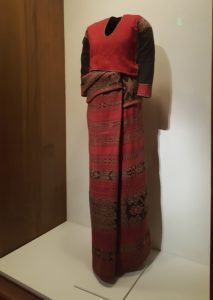
One of my favorite textile objects in the museum, a woman’s shirt and skirt or dagmai from the Philippines, about 1900, from the Arts of the Pacific section of the museum.
both in America and across the globe. I believe that through the endeavor of creating something for the public to expose these threads of connection across time, I’ve learned a lot more than I ever could have in a classroom setting. I’m not working toward an assignment for a grade; I’m creating the art of ideas and discovery through building an exhibition of art across time.
While this exhibit likely won’t premiere until the tail-end of 2018, I’ll be excited to return to the MFA when the time comes to see the final results of my contributions to this project.
How’s Juno? (aka, She’s Causing Trouble): Drover ’19 at Boston MFA
Feb 17, 2017Last month I posted a blog about the comic adventures of my dog, Juno. Last week I followed up with another post about the card art featuring my doggie friends. Here’s another comic featuring the excitement she’s causing while I’ve been away, and a new card of particular sentimental value to me.
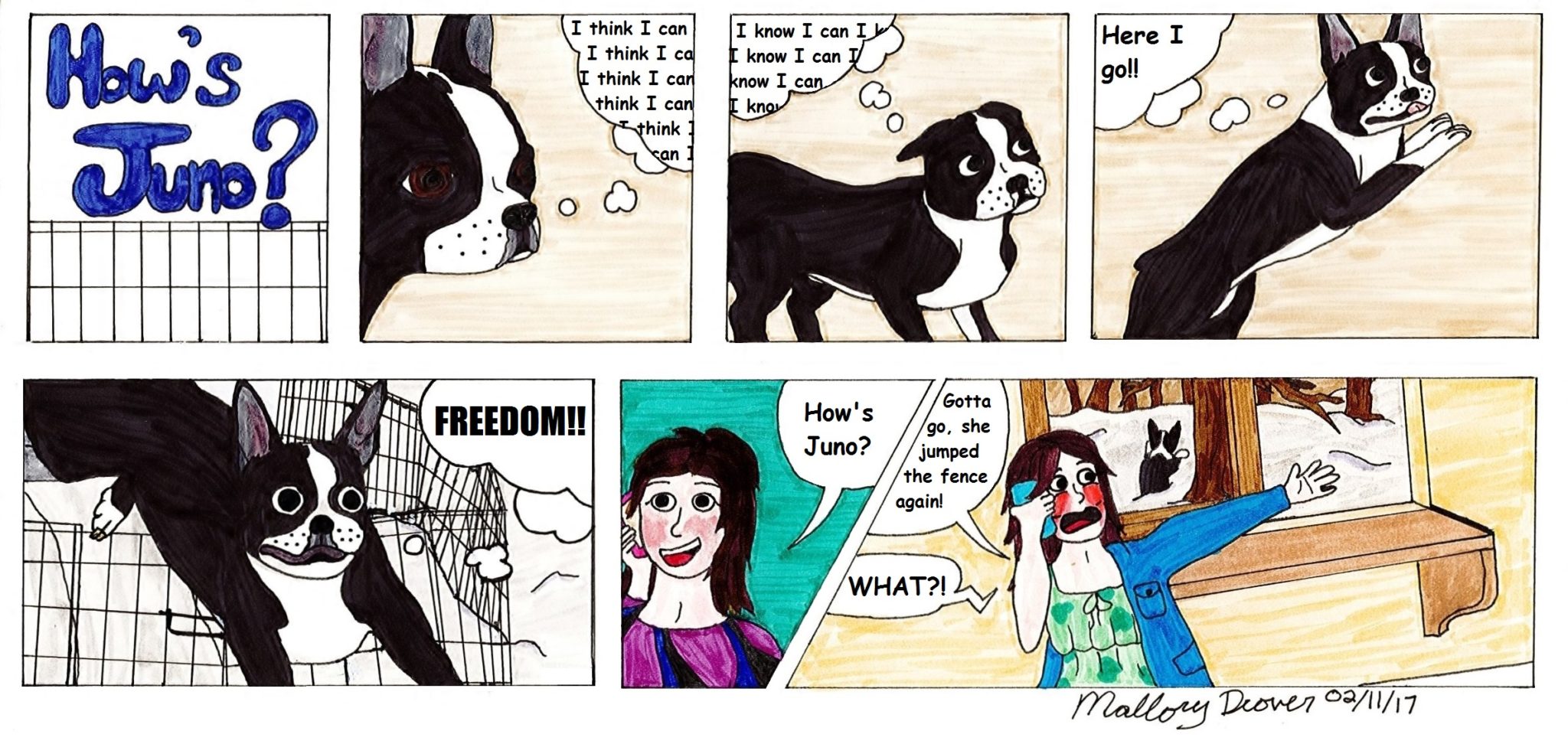
(True Story)
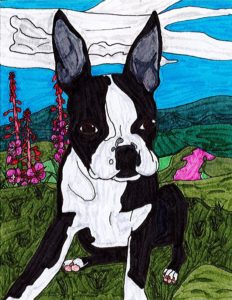
03/11/17 “Home Free”
The flowers in “Home Free” are Alaskan fireweed, and the rolling hills and valleys resemble my childhood home.
“How’s Juno?” (aka, Homesickness as Inspiration): Drover ’19 at Boston Museum of Fine Arts
Jan 22, 2017Not long after beginning my winter ’17 co-op in Boston, I became homesick and started drawing comic art of my dog while commuting to and from the MFA on the T. Juno, a young Boston Terrier, is still in Yellow Springs with my sister. Since starting my sketches on the T, I’ve given my comic strips the title “How’s Juno?” after the first lines of my first comic, and the first question I usually ask my sister when we speak on the phone.
Since my notebook doodles evolved into comic strips, my character art for each of the household’s three dogs has improved overall and become more consistent (although my human characters might need some more practice).
- Comic #1, finished 01/28/17. Originally, Juno was only going to be able to speak in hashtags.
- Comic #2, finished 02/01/17. Dogs are allergic to a lot of things besides chocolate.
- Comic #3, part 1, finished 02/12/17. Sweet Pea is my sister’s dog, a Brussels Griffon.
- Comic 3, part 2, finished 02/12/17. Sweet Pea has been in the family for a long time.
- Comic 3, part 3, finished 02/12/17. My sister and I currently have shared custody of Gigi, our mother’s dog.
“How’s Juno?” (aka, She’s On A Card): Drover ’19 at Boston Museum of Fine Arts
Jan 07, 2017Last month I posted a blog about a series of comic strips I’d started to draw while homesick for my dog, Juno. While I haven’t stopped creating the comic strips, I have also begun creating images for cards. The inspiration took me while meeting Mrs. Karsh, the wonderful woman who’s made my co-op with the MFA Boston possible, at a Valentine’s Day lunch. Several people also in attendance had brought her valentine’s day cards, and I was internally berating myself for not thinking to bring anything. One of the cards gifted to her had special artwork featuring several small dogs on the cover, which an MFA staff-person had printed just for her. That’s when it struck me that I could make my own card and send it to her later as a thank-you.
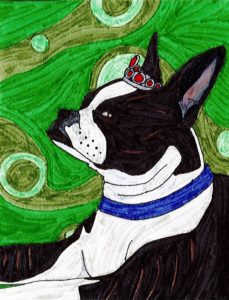
“Queen Gigi”
Although my first intention was to create a card for Mrs. Karsh, I learned late in the day that February 14th was also Michelle’s birthday. (I mentioned Michelle in a previous post about my experience thus far with the MFA.) Therefore, my first creation went to Michelle (a day late) as a birthday card. I used my mother’s dog as a model to create “Queen Gigi.” On the inside of the card read “My preferred pronouns are the Royal We,” a play on the gender-bending exhibition we’ve been working on.
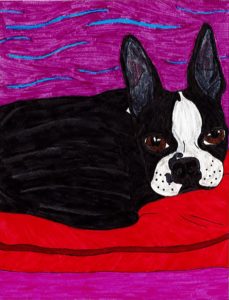
“Juno At Rest”
The next day I finished my thank-you card for Mrs. Karsh, which I titled “Juno At Rest.” The pose was based off a photo of Juno from when she was less than a year old, curled up in a sleeping position with her eyes open, ears perked, watching me watch her. It’s one of my favorite photos of my dog.
Since then I’ve made another birthday card for a co-worker titled “Sweetheart,” or alternatively “The Sweetheart Pose.” I’ve also created a few that don’t yet have a recipient: “Out For a Walk” and “Belly Rubs,” which both feature Juno, and “Nap,” which features both Juno and Gigi.
My most recent card features the late dog, Pugsley. Pugsley belonged to my older brother, who rescued the then-two-year-old pug from a bad home back in Alaska. The pair became inseparable for over a decade before Pugsley passed away a couple years ago, and my brother still gets choked up when we talk about him. I’m considering adding a stuffed squirrel to the picture, which was Pugsley’s favorite toy.
- “Out For A Walk”
- “Belly Rubs”
- “Nap”
- Early sketching.
- Outline finished.
- “Pugsley”
Space Week: Mallory Drover ’19 at Yellow Springs Children’s Center in Yellow Springs, Ohio
Jun 15, 2016My second week working for the YSCCC was Space Week.
I have to admit that I was very excited. At least once a week, the YSCCC teachers get together and do curriculum planning. Together they create a week-long lesson plan with a theme. They schedule projects, reading, and activities that reflect the theme. On my first day of work, I was invited to participate in curriculum planning for the following week, which would be space-themed.
I cannot imagine a better way for me to have begun my co-op than creating activities and projects to teach children about space. I still remember the distant wonder of possibilities that outer space seemed to hold when I was a child. As an adult, my fascination continues through a love of science fiction books, movies, and shows. On my first day of work, I was more than ready to help plan for Space Week.
 My first responsibility was to come up with a list of interesting facts about each of the planets in our solar system. This was one of my suggestions for the curriculum, because I hoped that interesting and off-hand facts would be engaging enough to stick in the minds of at least one or two of the preschoolers. I gathered facts, wrote them in bright colors, and gathered them onto posterboard. I was invited to give my little presentation in place of a story book for circle time.
My first responsibility was to come up with a list of interesting facts about each of the planets in our solar system. This was one of my suggestions for the curriculum, because I hoped that interesting and off-hand facts would be engaging enough to stick in the minds of at least one or two of the preschoolers. I gathered facts, wrote them in bright colors, and gathered them onto posterboard. I was invited to give my little presentation in place of a story book for circle time.
 I found that enthusiasm seems to be the key to engaging preschoolers in just about anything. If you are excited about something, that excitement is contagious. I showed them my fact board, read aloud about each planet, and engaged in further explanations and questions. I explained why Pluto used to be considered a planet, and why it no longer is. I explained what makes Mercury the fastest planet, and the difference between its speed and Earth’s speed. Most of the kids did not want to believe that there is a massive storm on Jupiter that has lasted more than 300 years!
I found that enthusiasm seems to be the key to engaging preschoolers in just about anything. If you are excited about something, that excitement is contagious. I showed them my fact board, read aloud about each planet, and engaged in further explanations and questions. I explained why Pluto used to be considered a planet, and why it no longer is. I explained what makes Mercury the fastest planet, and the difference between its speed and Earth’s speed. Most of the kids did not want to believe that there is a massive storm on Jupiter that has lasted more than 300 years!
 Overall, Space Week was a success and a blast. I helped the kids and my co-workers hang up stars and the planets in the Science Room. The kids decorated a rocket simulator, complete with a control system. They took turns sitting in the rocket, choosing which planet to visit next, and I assisted as the voice of “Ground Control” to “Major Tom.” With my hands cupped over my mouth to create a radio voice, I counted down from 10 to blast-off, and continued to narrate facts and observations each time we “landed” on a planet or moon. Later, the preschoolers invented their own aliens, made their own planets out of paper mache and paint. The after-school kids walked the length of a football field to understand the scale of distance between each of the planets, starting from the sun and ending with Neptune. They built their own bottle rockets, and completed worksheets about the solar system.
Overall, Space Week was a success and a blast. I helped the kids and my co-workers hang up stars and the planets in the Science Room. The kids decorated a rocket simulator, complete with a control system. They took turns sitting in the rocket, choosing which planet to visit next, and I assisted as the voice of “Ground Control” to “Major Tom.” With my hands cupped over my mouth to create a radio voice, I counted down from 10 to blast-off, and continued to narrate facts and observations each time we “landed” on a planet or moon. Later, the preschoolers invented their own aliens, made their own planets out of paper mache and paint. The after-school kids walked the length of a football field to understand the scale of distance between each of the planets, starting from the sun and ending with Neptune. They built their own bottle rockets, and completed worksheets about the solar system.
Space Week was so fun and successful, we extended it for an extra!
In the second week, I built a constellation box for the kids. There are a few different ways to make a constellation box, but mine was a bit different than the traditional boxes. I taped the box together tight enough that you couldn’t see any light through any gaps, cut a rectangle on one end almost as big as a piece of printer paper, and cut two round holes at the top for looking inside. I created slides of a number of constellations from paper and cardboard, with holes as thick as a pencil where the stars needed to be. Once all that was done, we could place a slide of each of the constellations one at a time into the slot that covered my box’s rectangular hole. When we shined a bright light on the slide and looked through one of the viewing holes, we could see the stars dance inside the box like they do in the night sky. One boy enjoyed watching me make the slides, and he became so excited that he made up his own constellation and named it “Grabber.” We turned his constellation into its own slide, which is now stacked with the other slides for the kids to use later.
- “Grabber”

A presentation by Bill Nye I attended at the University of Alaska Anchorage, in October of 2015.
Perhaps one of my favorite experiences from Space Week happened with the after-school kids. One boy that I had not spent very much time with yet came to me with a question about outer space. One question lead to another, until we had spent over an hour talking about the science and properties of space. What happens to fire in space? What would happen if you took off your helmet in space? What’s the longest a person can survive exposure in space? How does water function in space? How is moon dust different than Earth dust? I almost could not believe it when he told me that he had never heard of Bill Nye the Science Guy! I explained what the Bill Nye show was like, that Bill has always been a real scientist, and all about his efforts to place a sundial on NASA’s 2001 Mars Surveyor Lander.
My final mission, once Space Week had come and gone, was to save the classroom decorations in the science room. The kids loved the planets so much, I offered to turn them into a mobile that we could hang from the ceiling.
My Work Day: Drover ’19 at Yellow Springs Community Children’s Center in Yellow Springs, Ohio
May 20, 2016I started my position with the Yellow Springs Community Children’s Center on April 4th of this year. I was nervous for my first day of my first co-op, and was a bit jittery as I prepared for new hire paperwork and training. My first impression of the YSCCC was of nostalgia, and a familiar sense of home. As a 22-year-old, it really was not that long ago when I attended preschool and children’s programs in my own hometown. The friendly and welcoming smiles, the crafting supplies, the sensory table, the play equipment- it all brought me right back to the same excitement and comfort I experienced when I was very young.

The Children’s Center has a long history in Yellow Springs. First opened in 1926, the Children’s Center celebrated its 70th birthday next week on Wednesday, May 12th. Their mission is to “to enhance the unique social, intellectual, emotional and physical growth of each child and to support their families.” Their philosophy is to provide the best environment for learning, care, and support for the children’s development and well being. While the teachers and staff of the Children’s Center use a number of methods and resources to achieve this, it is the level of compassion and dedication they each bring to their work that has the most incredible impact on the organization, and on the children.
I have not met a single person in the organization yet who does not bring 100% of their motivation and care to the children in their classrooms, day after day. I have never met a group of co-workers who behave more a family than those in the YSCCC. The uplifting atmosphere makes me feel like I shine brighter, and I know the children can feel it, too.


My position with the YSCCC is through the Antioch Miller Fellowship program. It is my job to work directly with the kids, assist the teachers, and contribute to program and curriculum planning and development. The Children’s Center has three programs to care for toddlers, preschoolers, and school-agers, covering ages 18-months through grade 6. Because I seem to work well with all three age groups, my work day is split between them.
I start my work day at 8am with the preschoolers for free-play. By 9am, we serve a healthy breakfast that caters to each of the children’s dietary needs, followed by planned activities and more free-play. By 10am, the preschoolers gather together for Circle Time. We do calendar activities such as singing the “Days of the Week” song, identifying which day it currently is, and where today falls in the week. We sing the “Weather Song,” and the children take turns identifying the day’s weather and dressing the velcro weatherman accordingly. The teachers read one or two stories that correspond to the day’s curriculum. By 11am, the children get outside-play. If the weather is not nice enough, we go to the Muscle Room to play instead. 11:30am is lunchtime, serving well-rounded meals that meet the needs of each child.
This is usually the time when I transition to the Toddler Room. I assist the toddler teacher with feeding the kids their lunch. When they finish, I help keep them entertained with playtime, stories, and songs. I use simple sign language as a communication aid with the children who are still learning to make themselves understood, and I comfort the toddlers who still have a hard time being away from their parents. By 12:30pm, I start helping the children get changed or pottied. By 1pm, we meet the preschoolers at the Nap Room and get everyone settled on their cots. By 1:30pm, most children should be settled or asleep. This is when I take my lunch break.

I arrive at the gym in Mills Lawn School by 2:30pm for the school-agers program. Once all the kids have arrived, they line up to use the bathroom and wash their hands, followed by a snack. The kids volunteer to take turns as food servers. After they finish eating, we have Quiet Time. Students do their homework if they have any, and read a book if they do not. Quiet Time ends at 4pm, and then we do an activity that relates to the week’s curriculum. Once the activity is over, we move outside to the playground until 5:30pm or so. By then most children have usually been picked up by their parents, and the rest move with us back to the gym for the remainder of our time.

Every work day, I see how the teachers and staff with the YSCCC build and cultivate relationships with each of their students individually. I listen as they share insights on what strategies work best for individual students. I see how the children grow and learn new things, and I listen to their thoughts about new discoveries.
Most of my previous work experience before now was as a Care Provider for individuals with developmental disabilities. I worked with people of all ages, but only with a couple children. Something that stuck with me the most from that job was the new understanding I gained about the human condition. Understanding the spectrum of human ability gave me a new perspective on the experience of being human, how and why human beings behave and feel the way that we do, and what we should value the most about our relationships with others.
From my time thus far on my first co-op, I am surprised and thrilled to discover yet more insights into the human condition. I am seeing things through a perspective that I have not experienced since I was in grade school myself, and it has reminded me of the wonder and hope of childhood. I am reminded of the inhibition for learning I used to have. I am reminded of my responsibility to treat others kindly. I am reminded of the excited optimism that used to drive me. My relationships and interaction with others has already improved in real time. I cannot wait to go back to work tomorrow.


